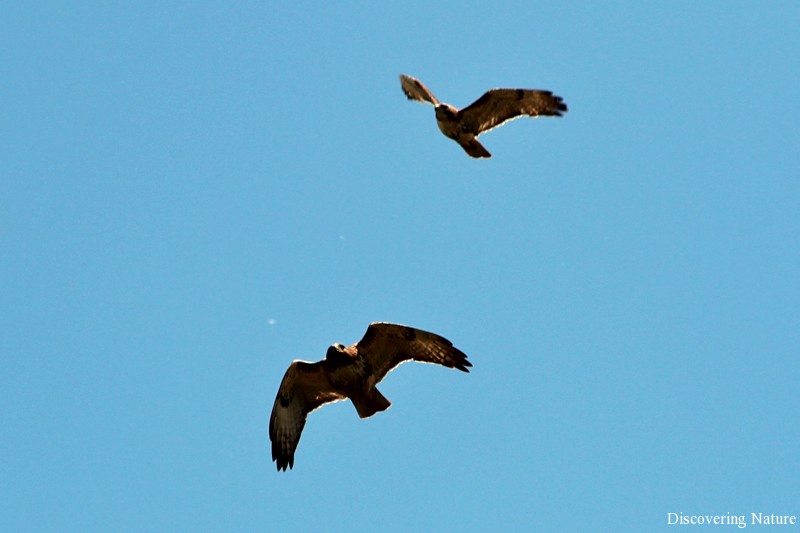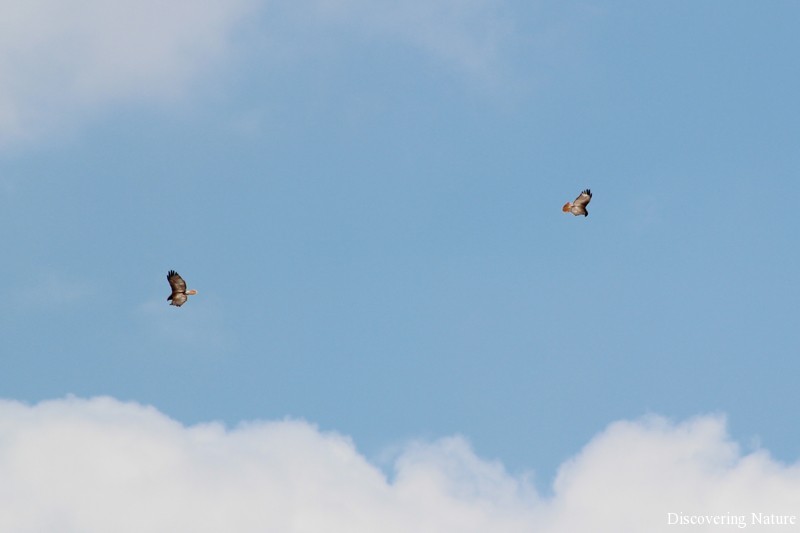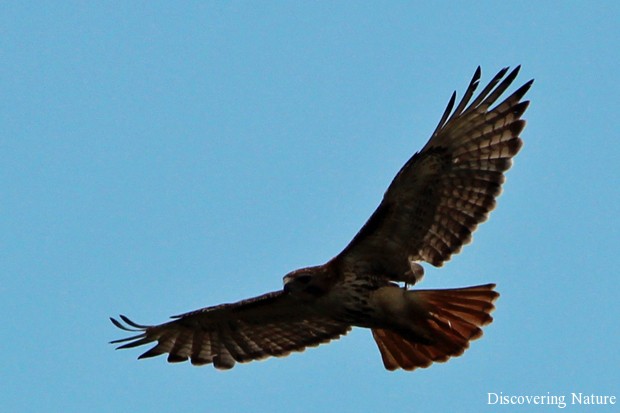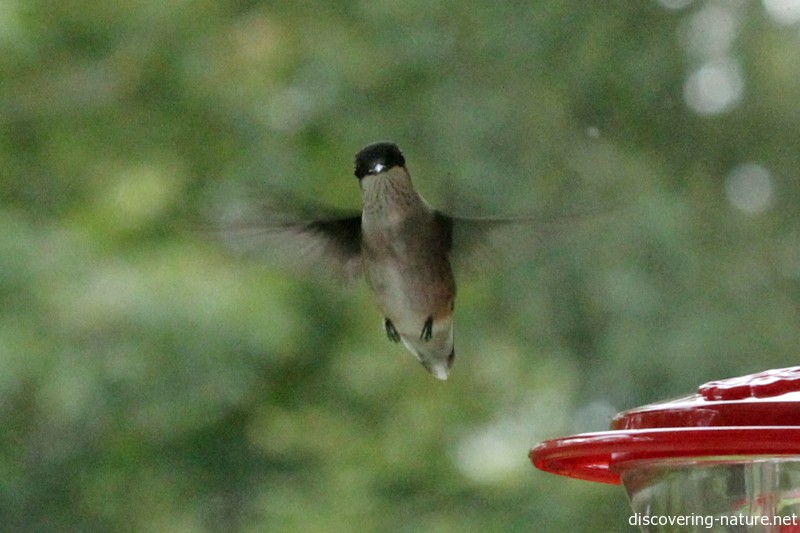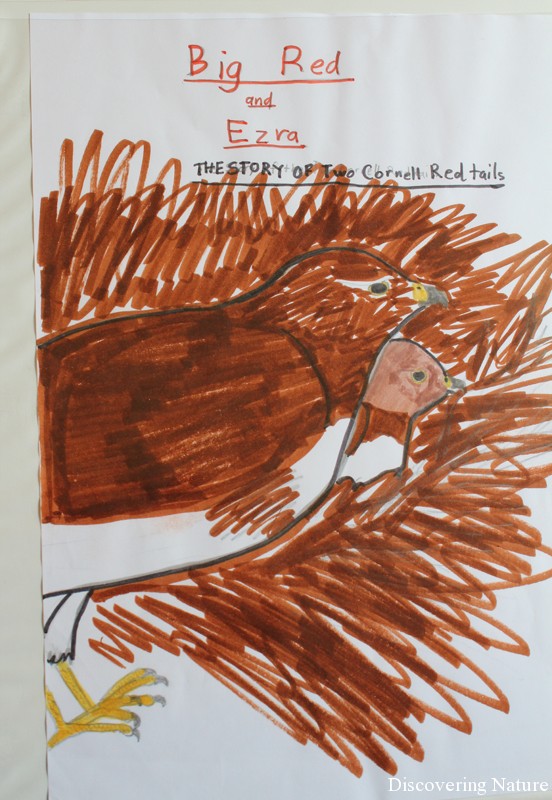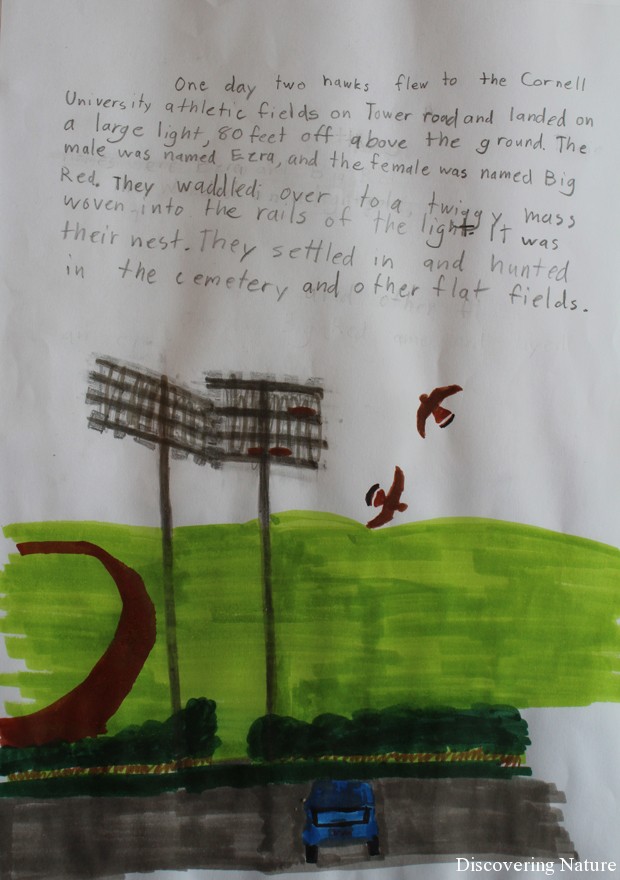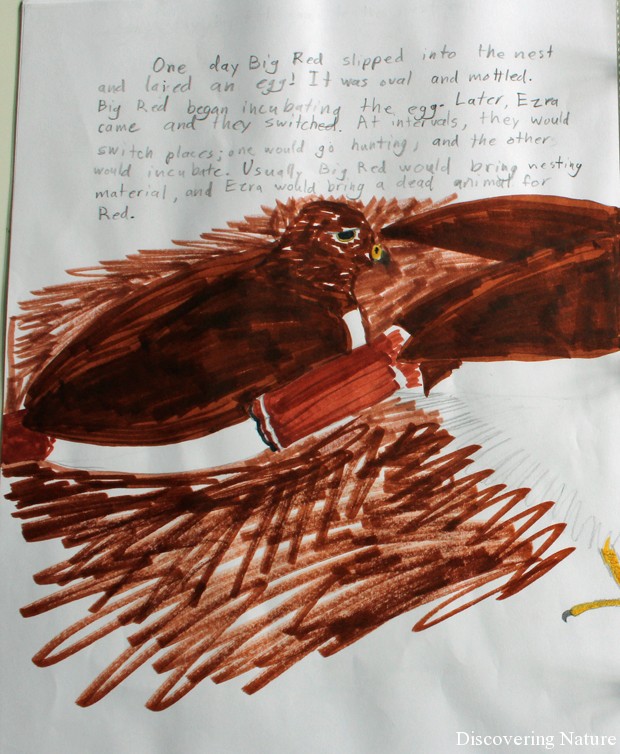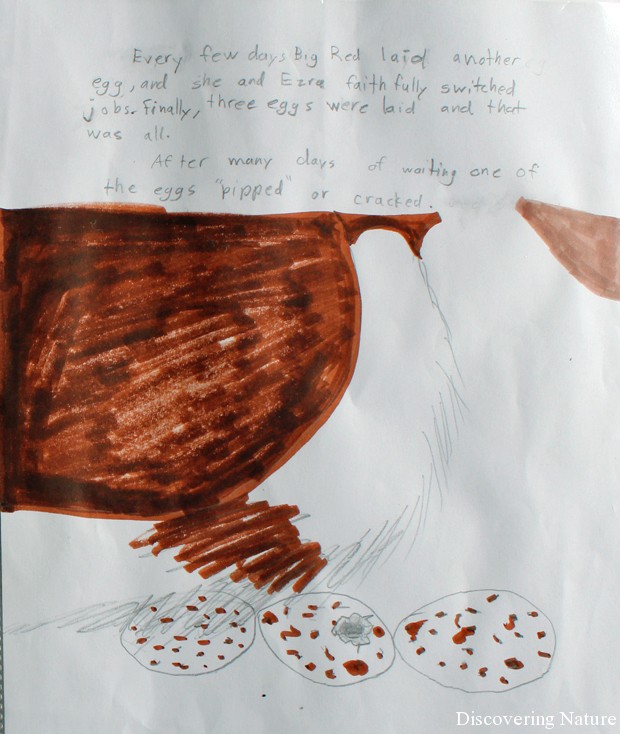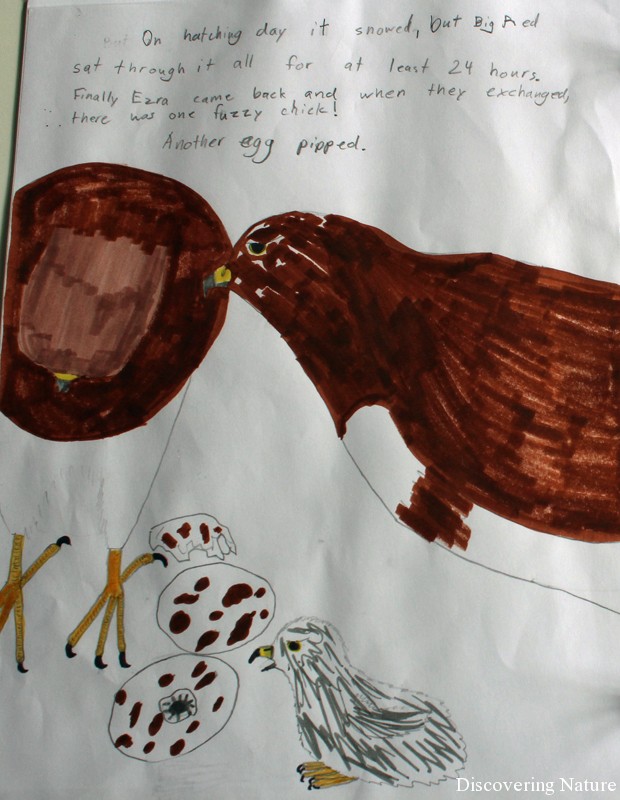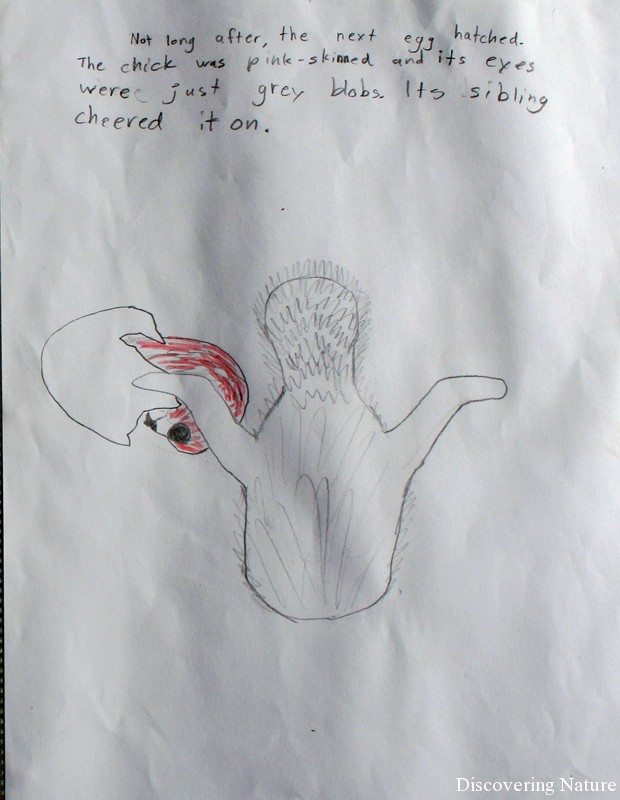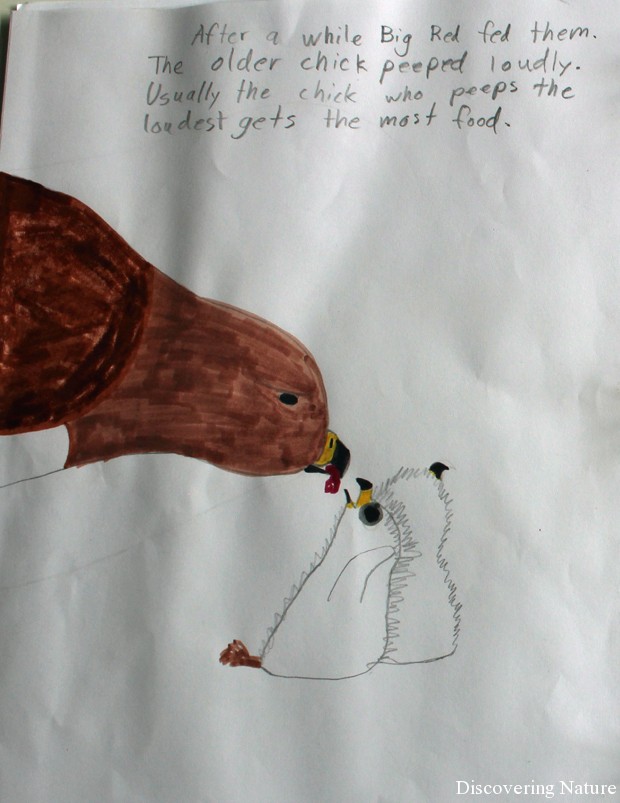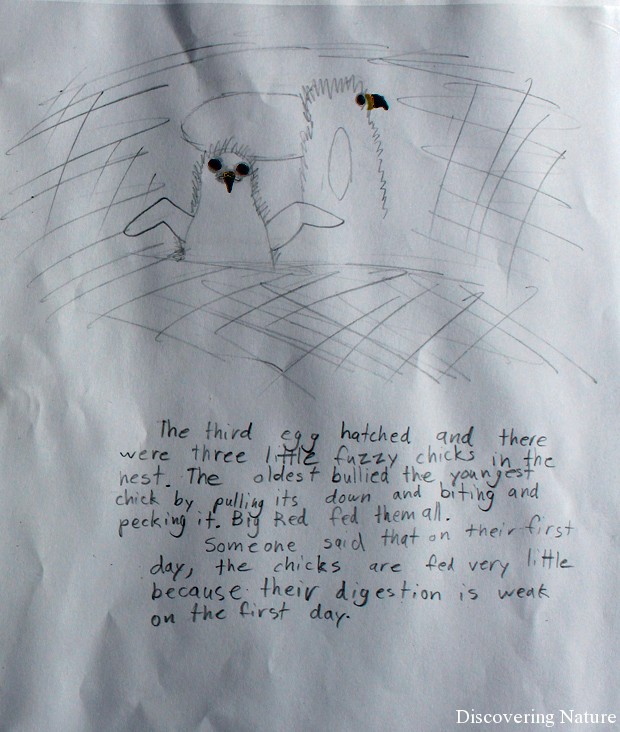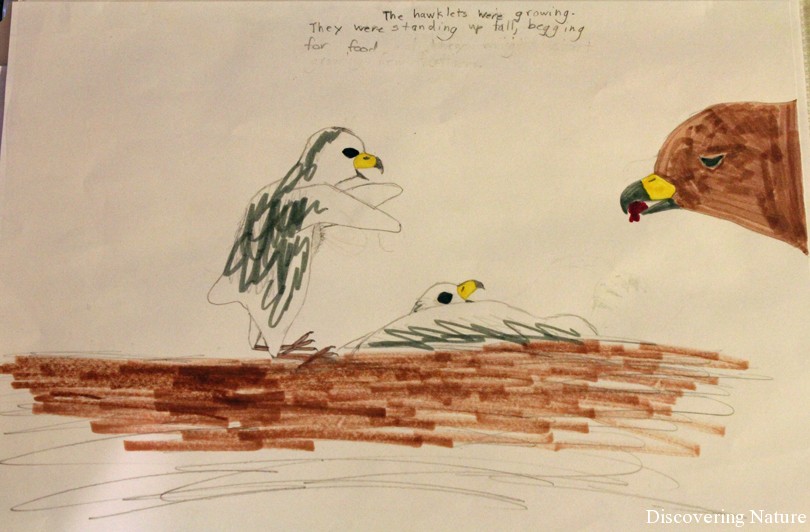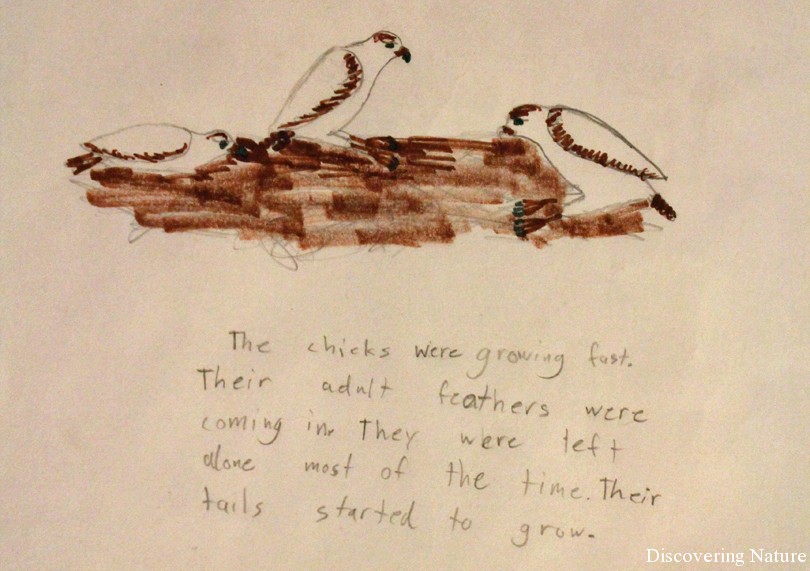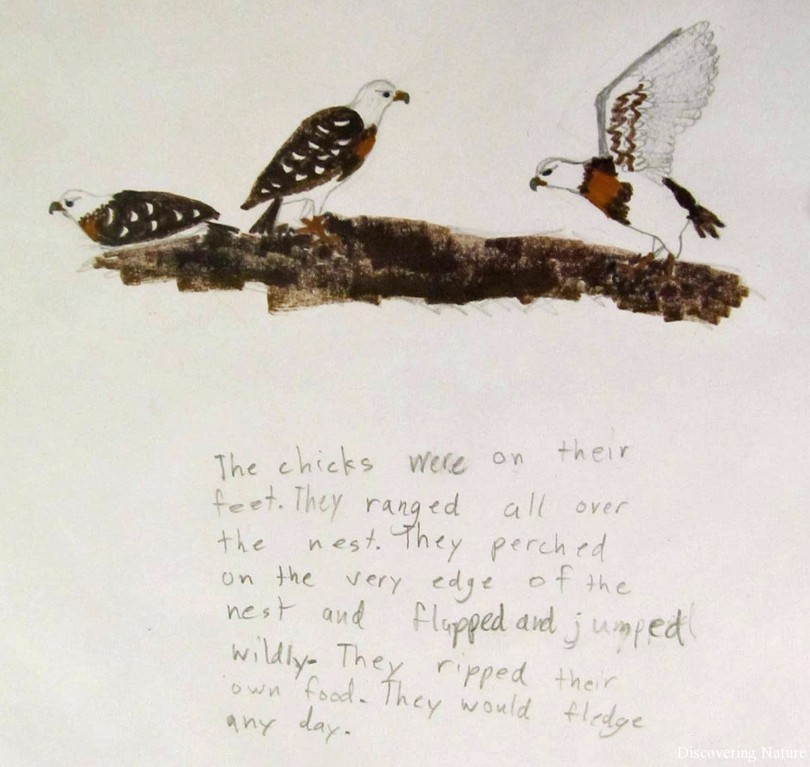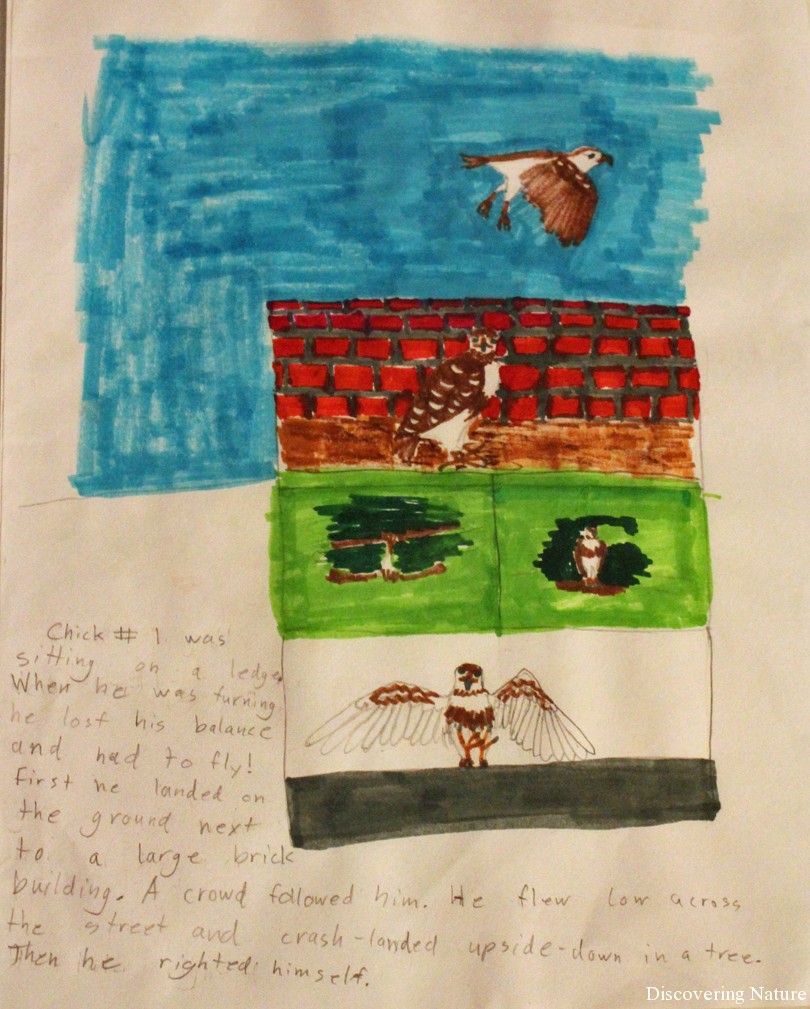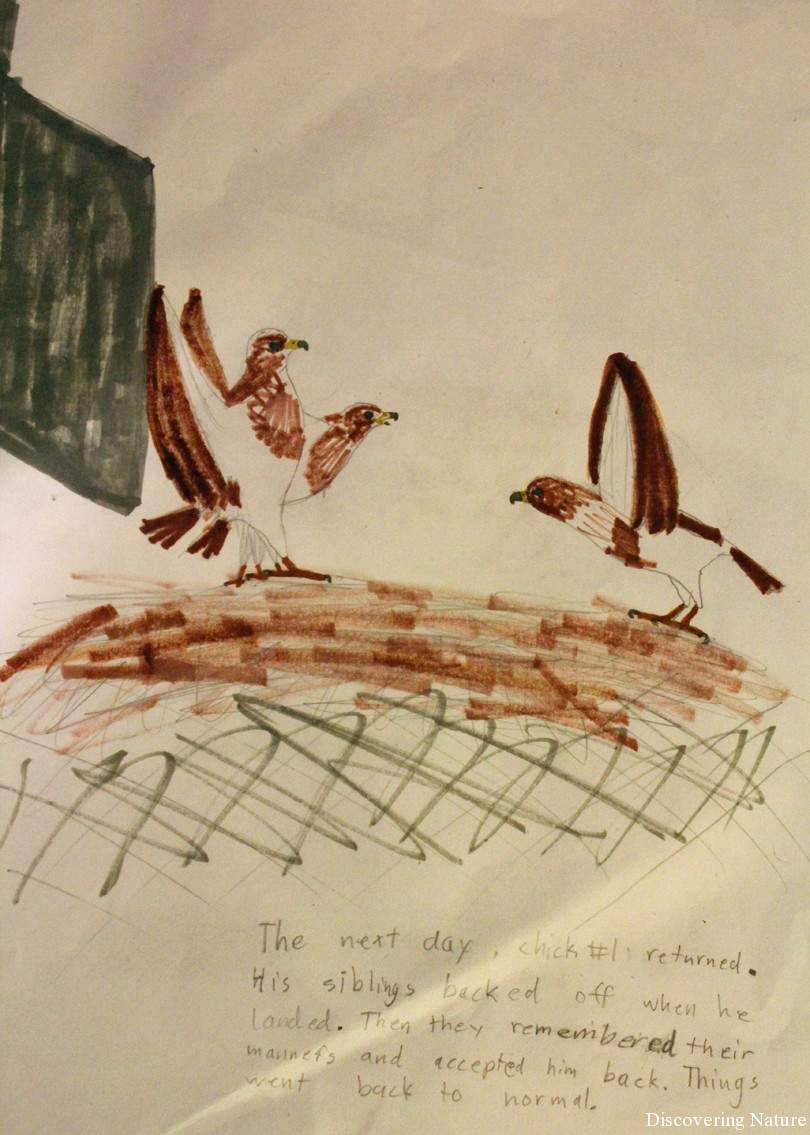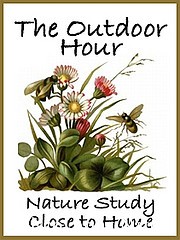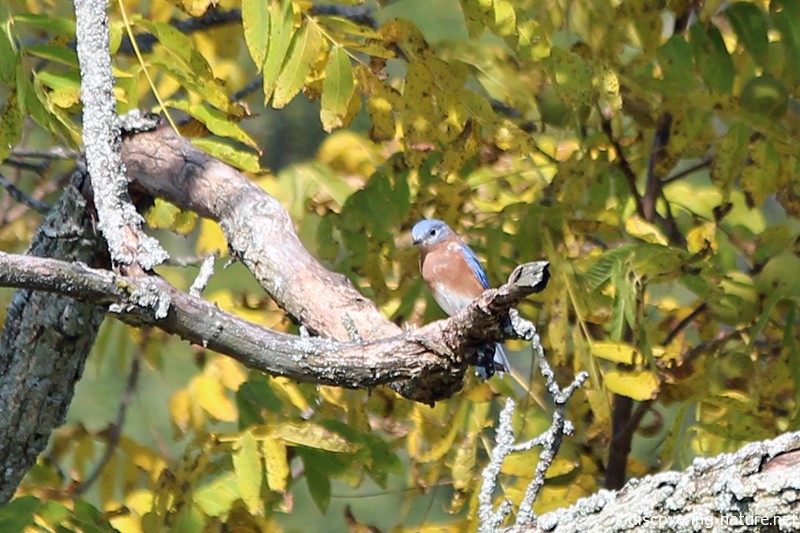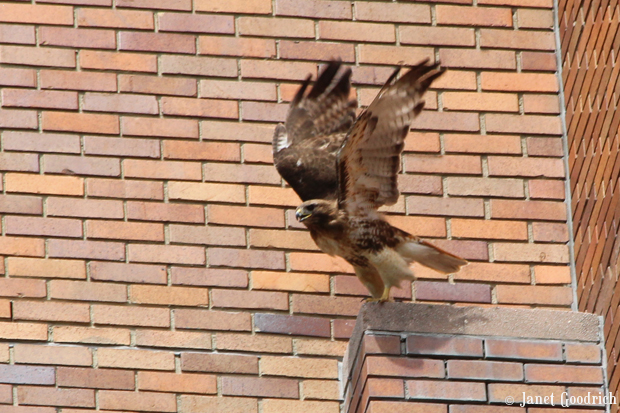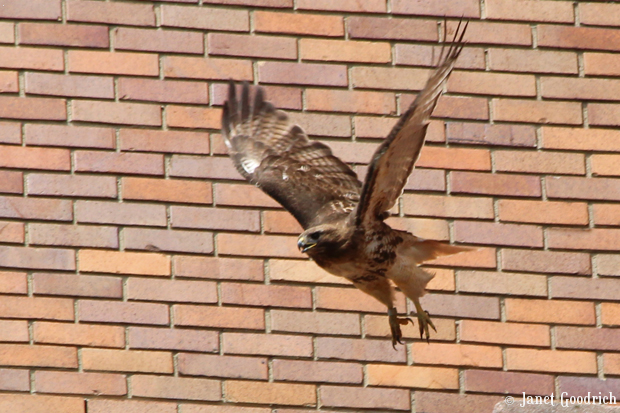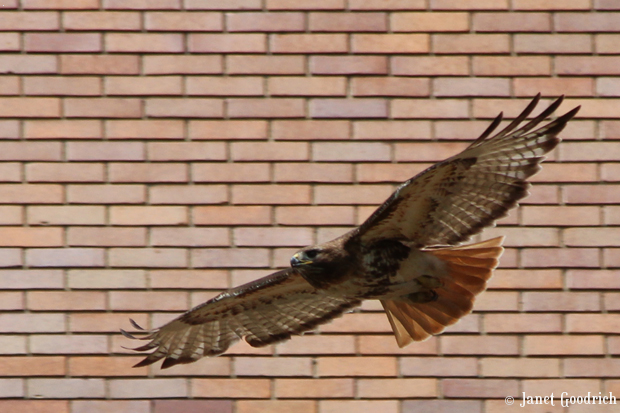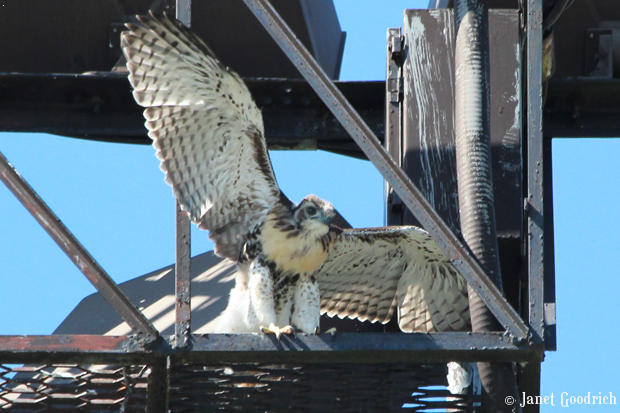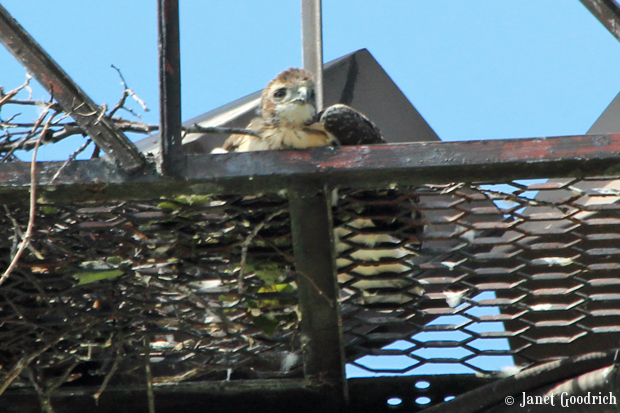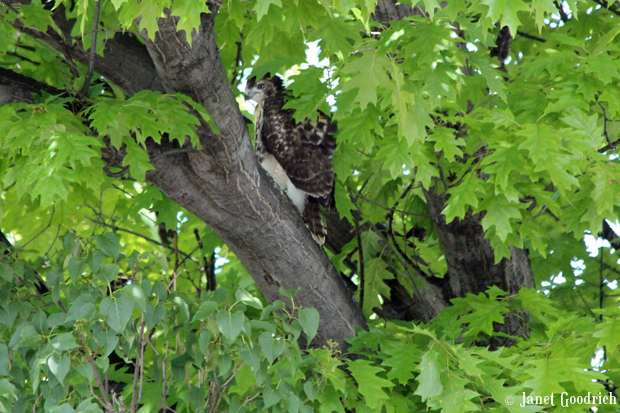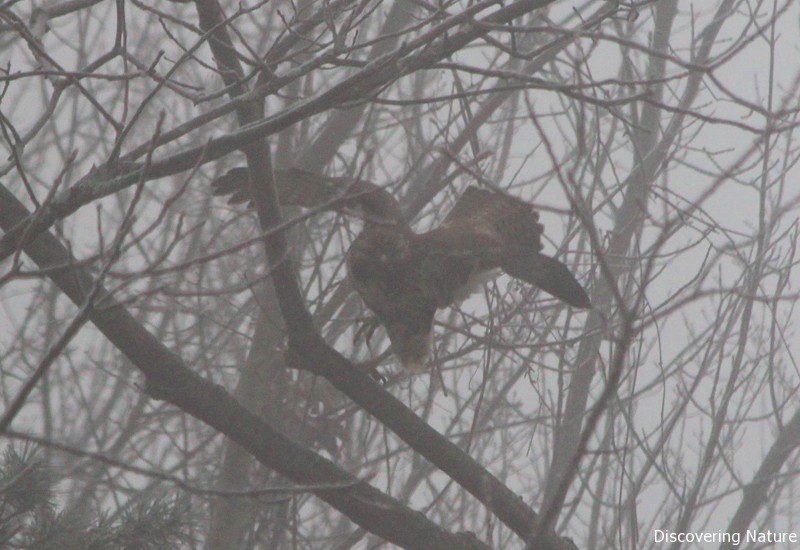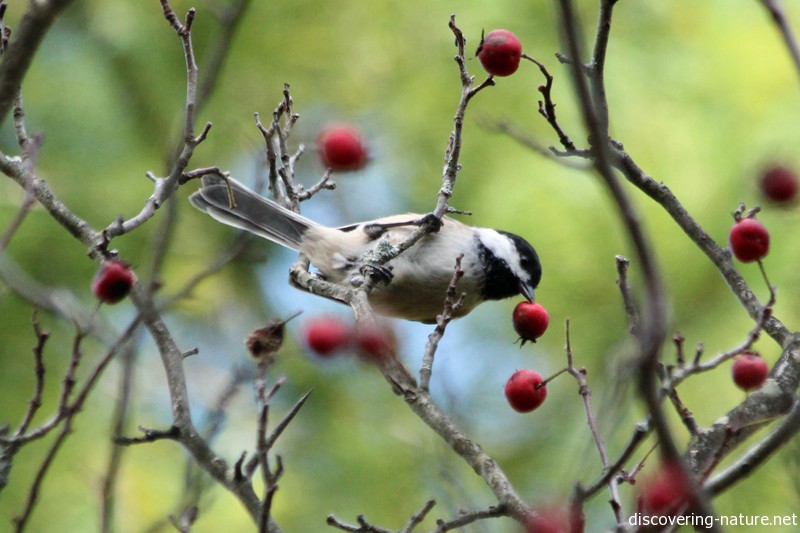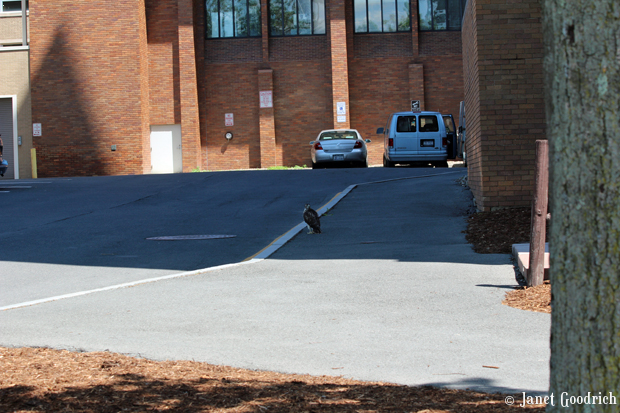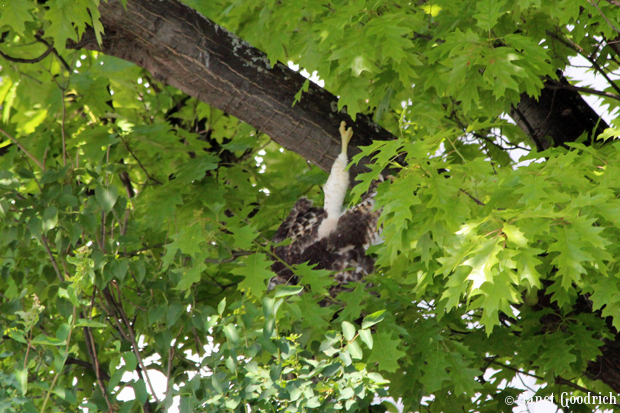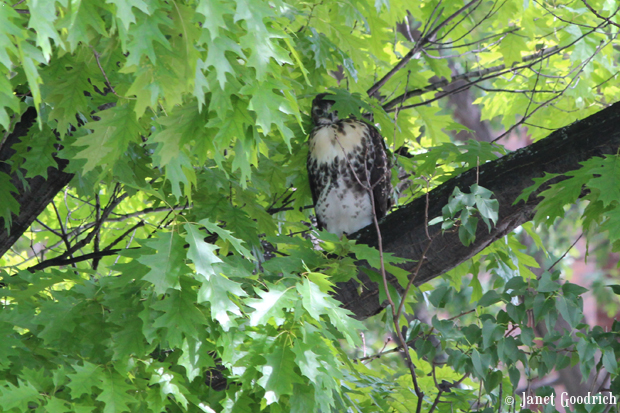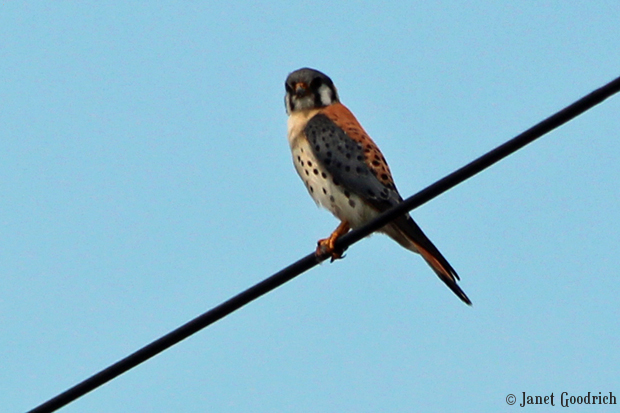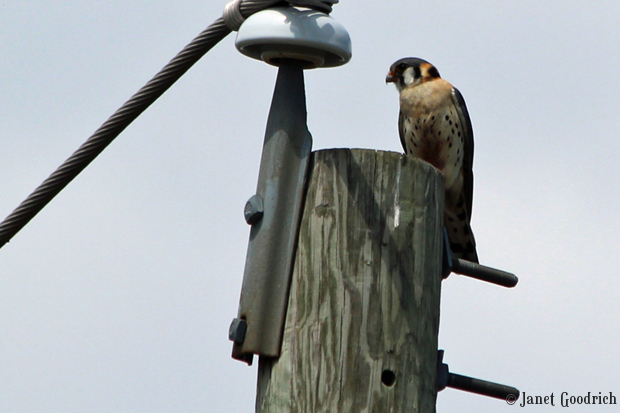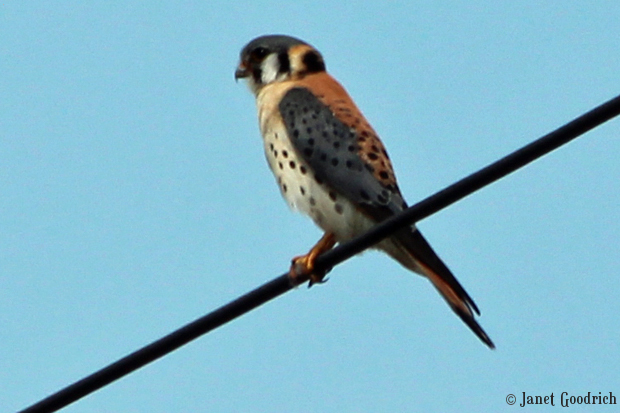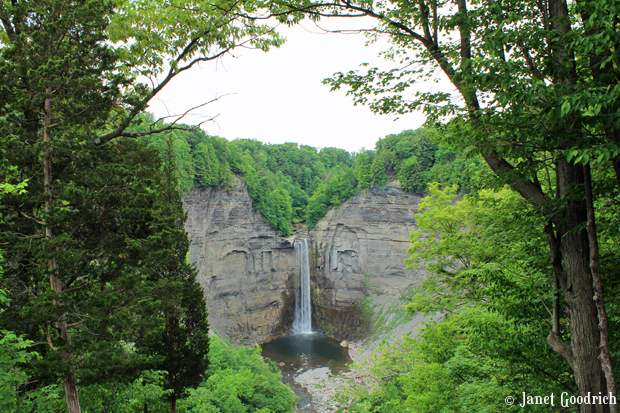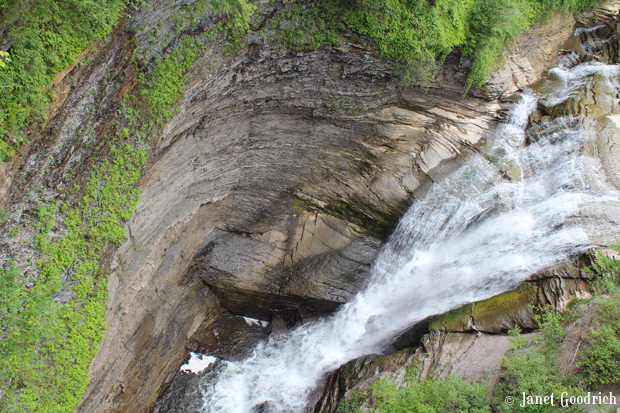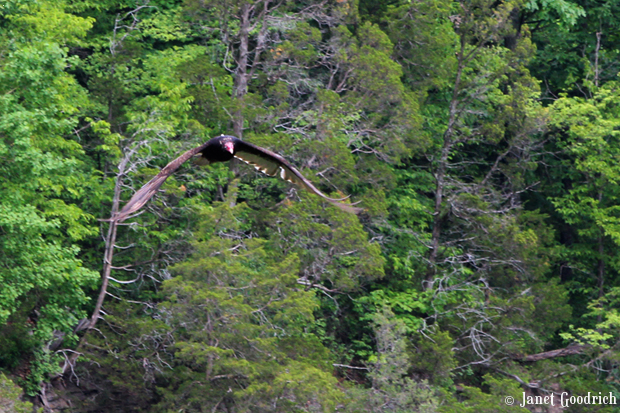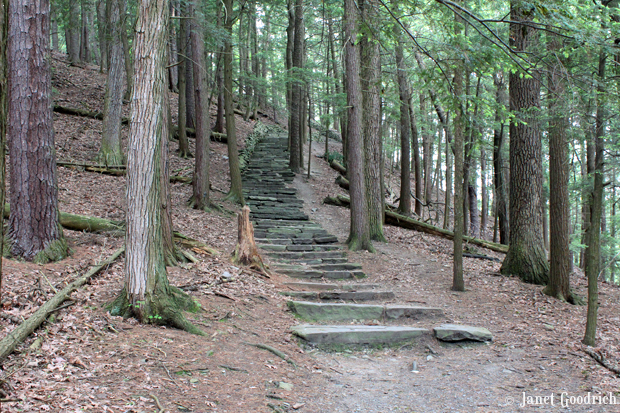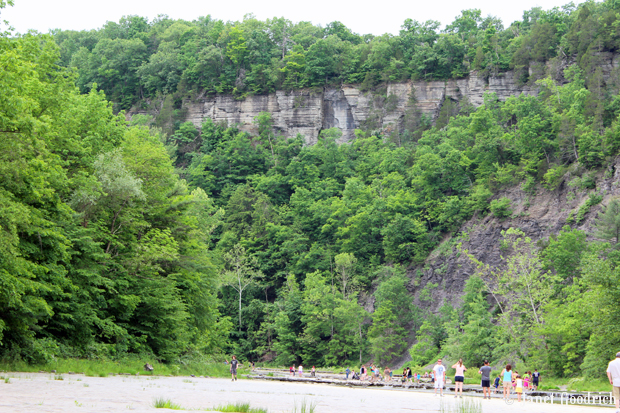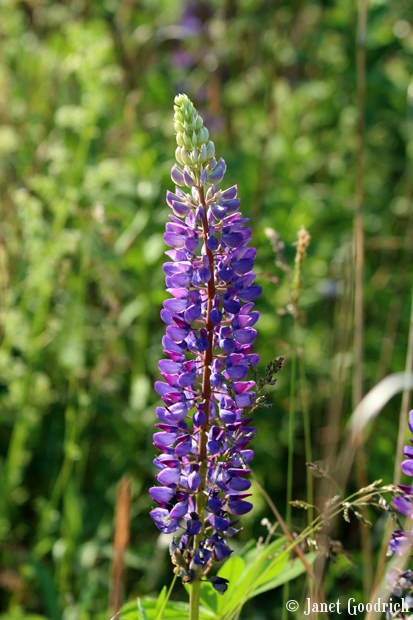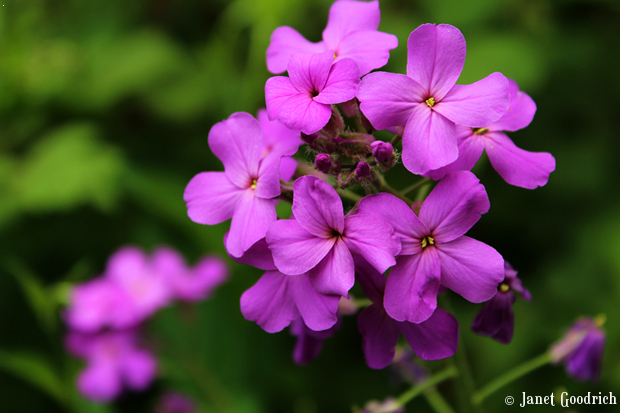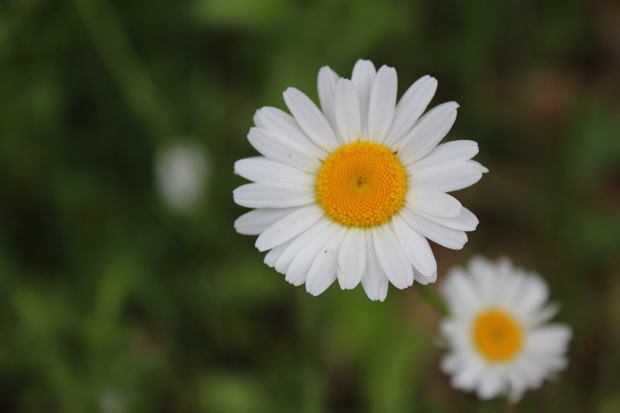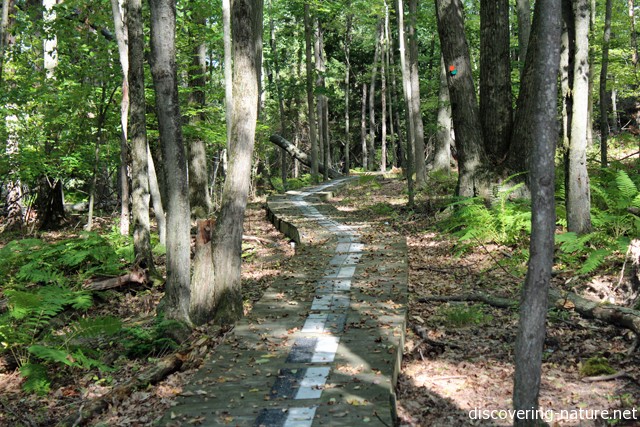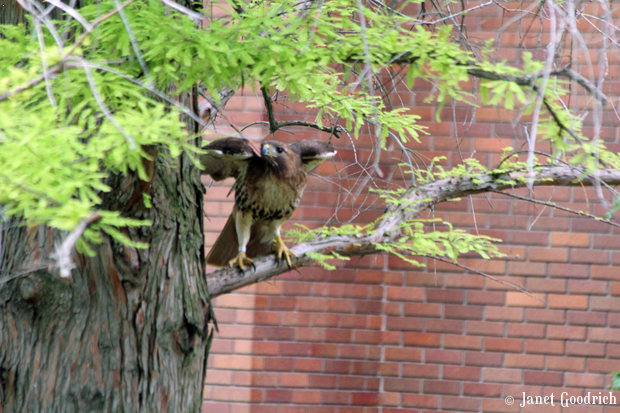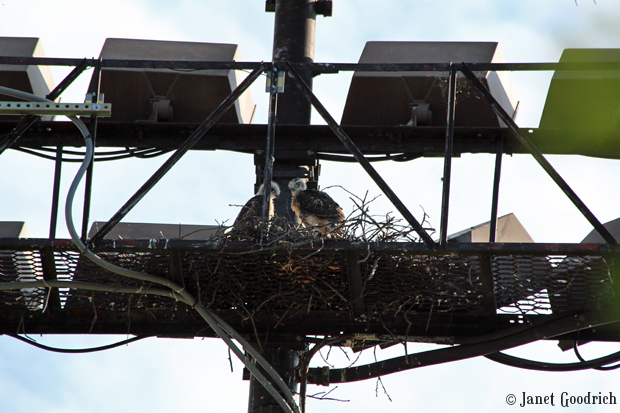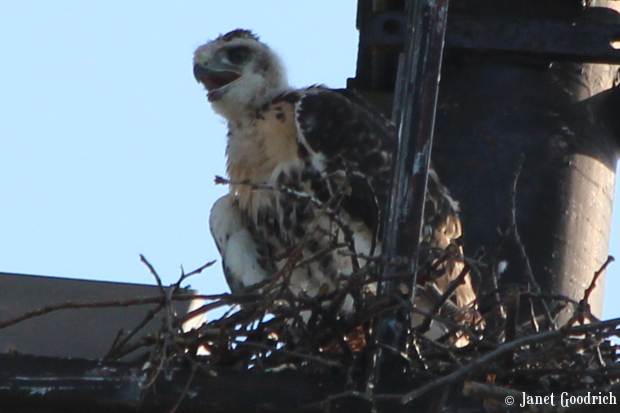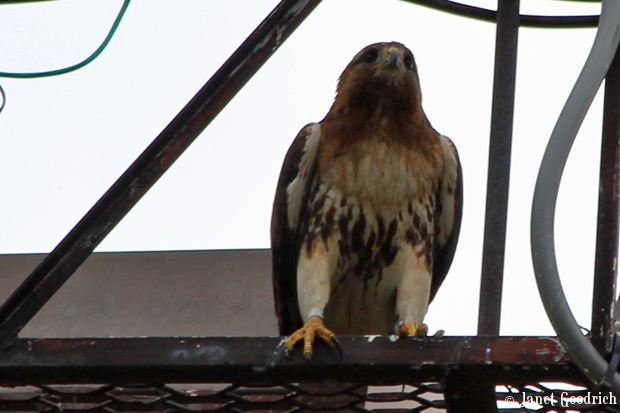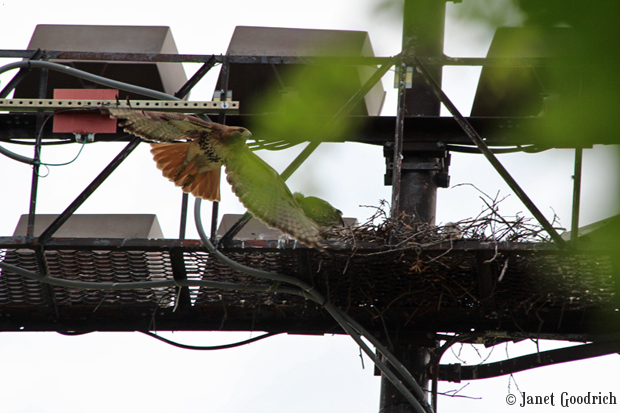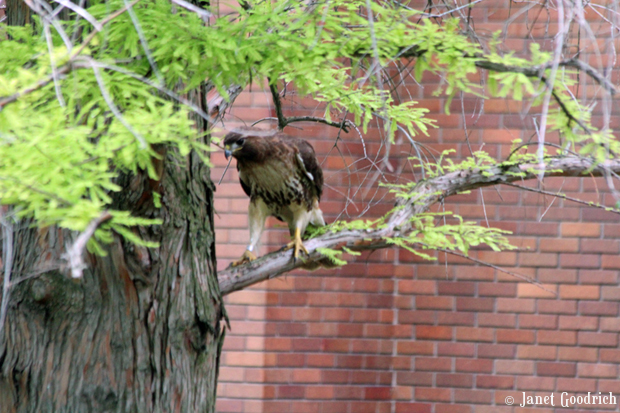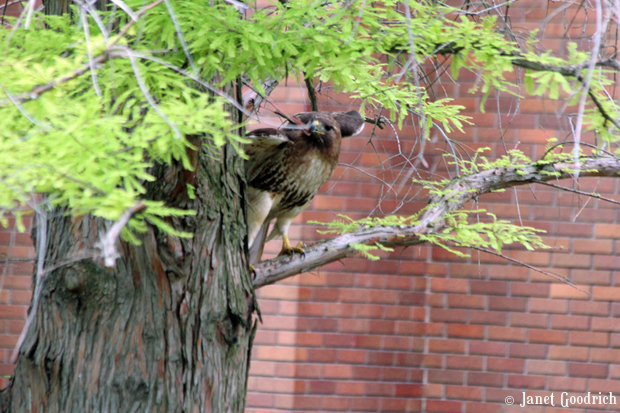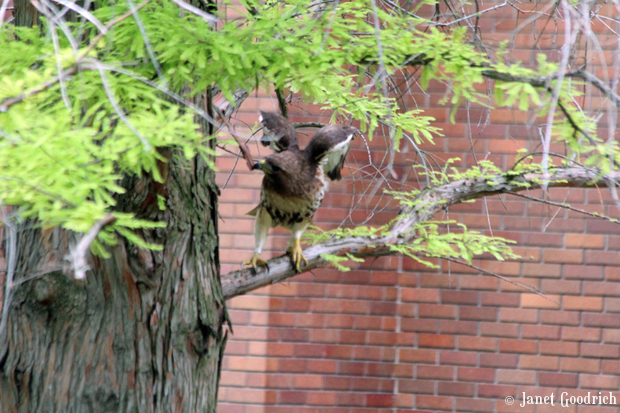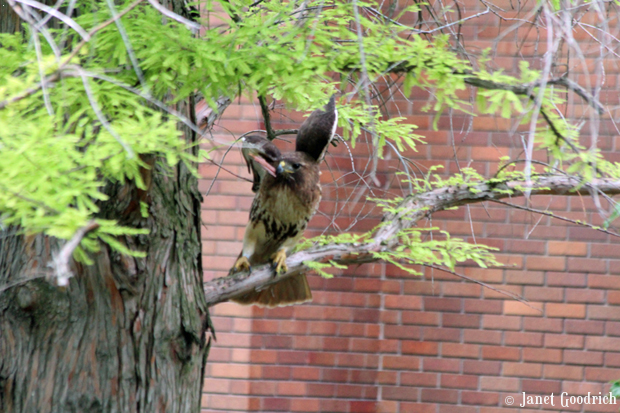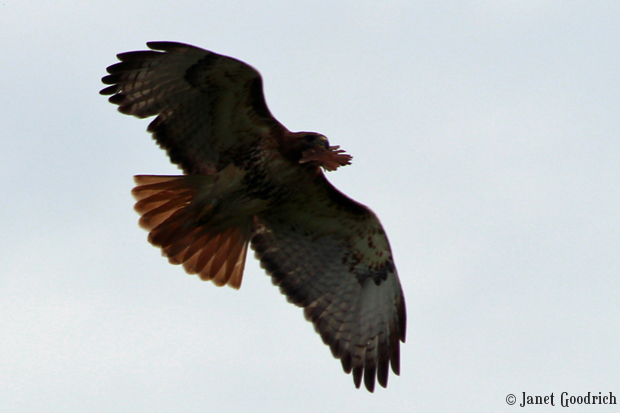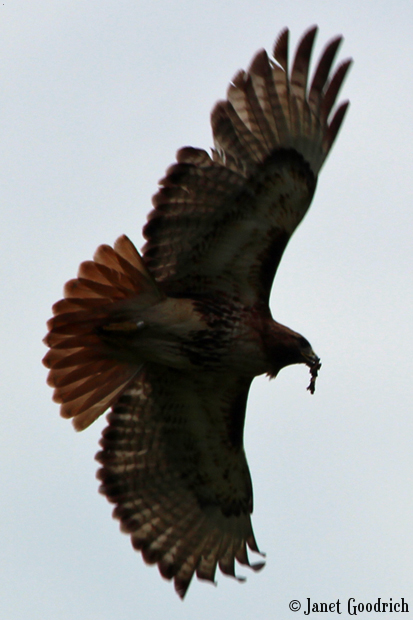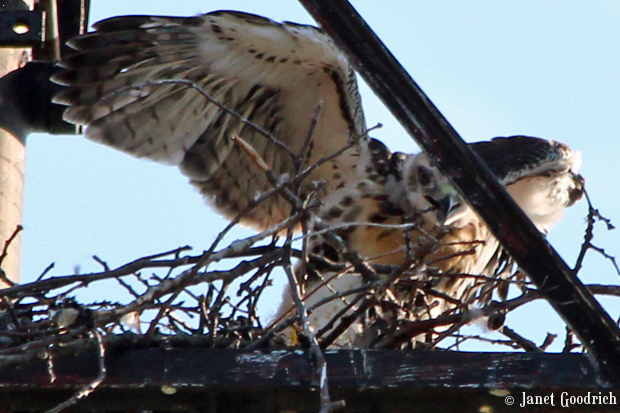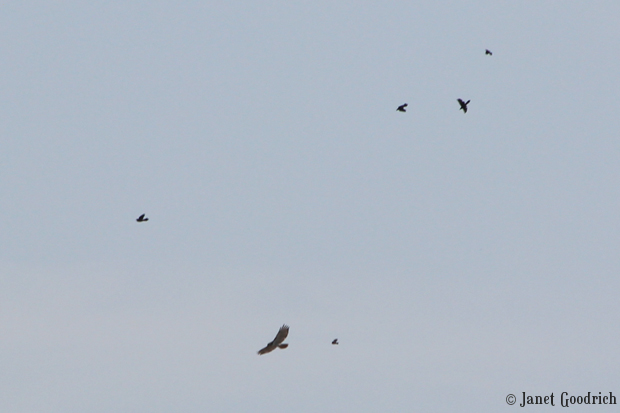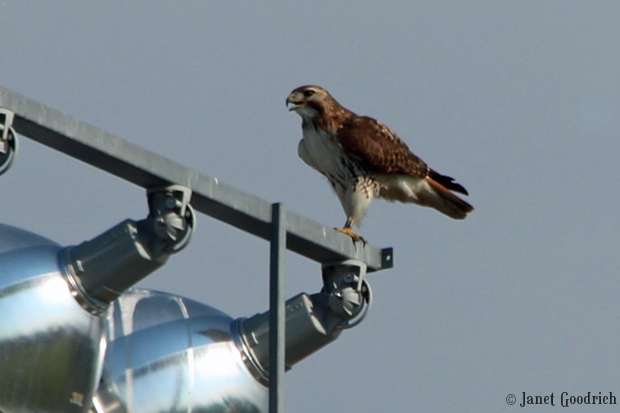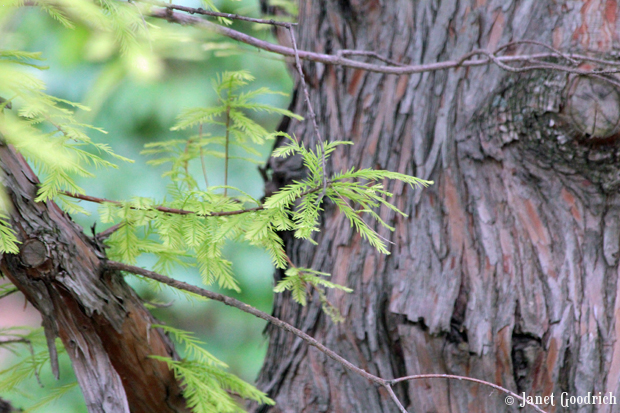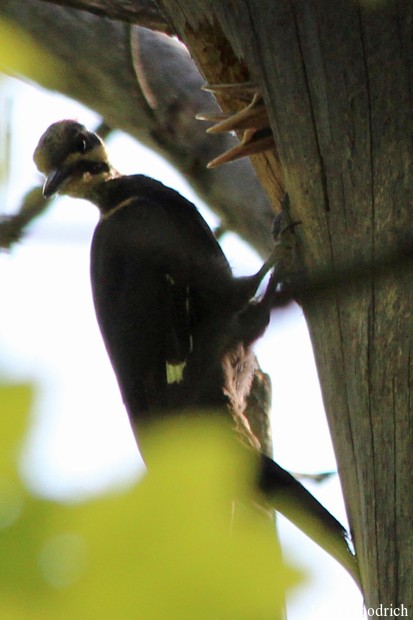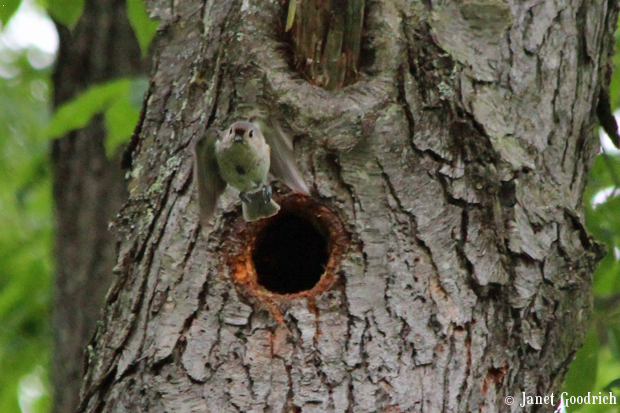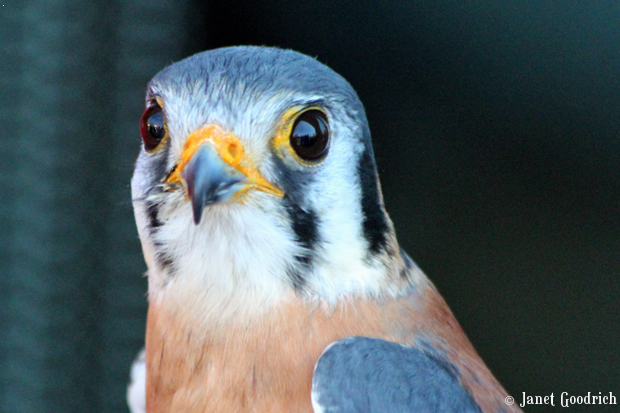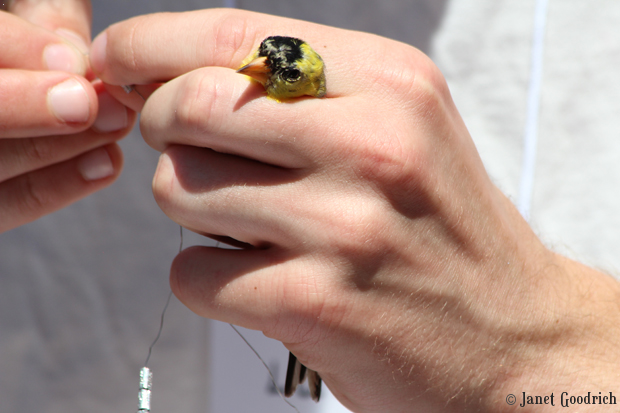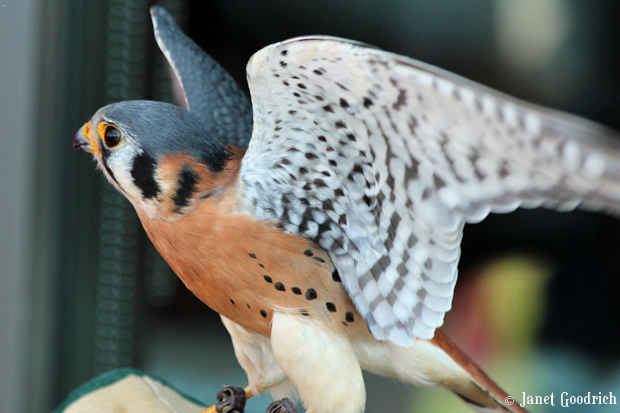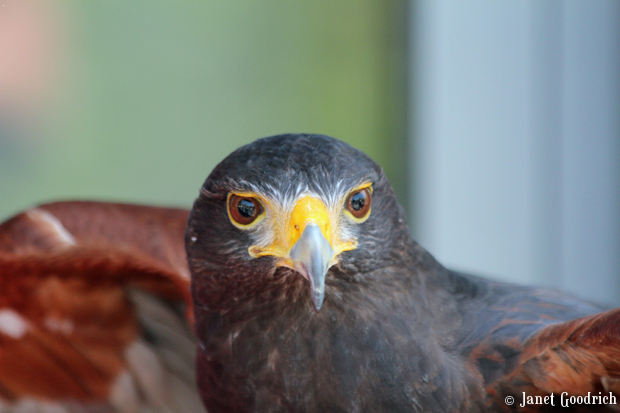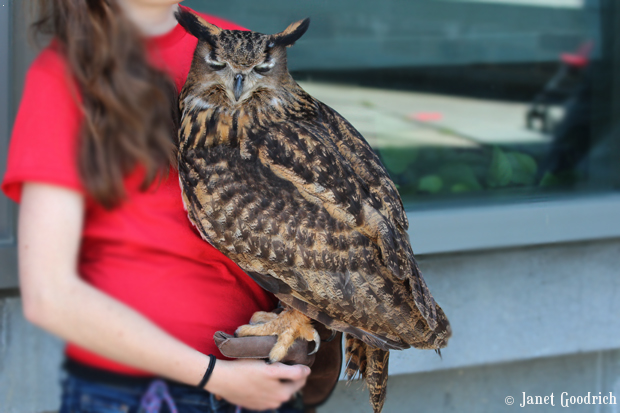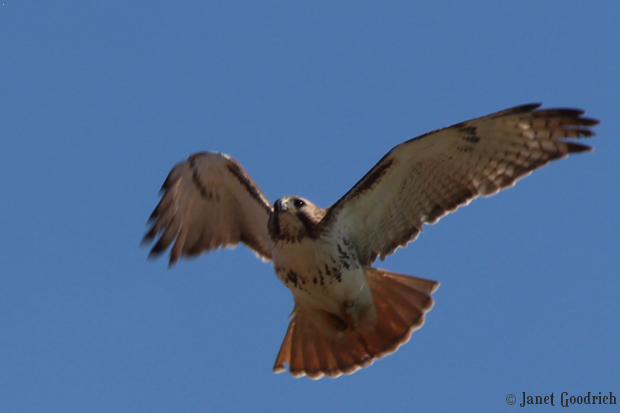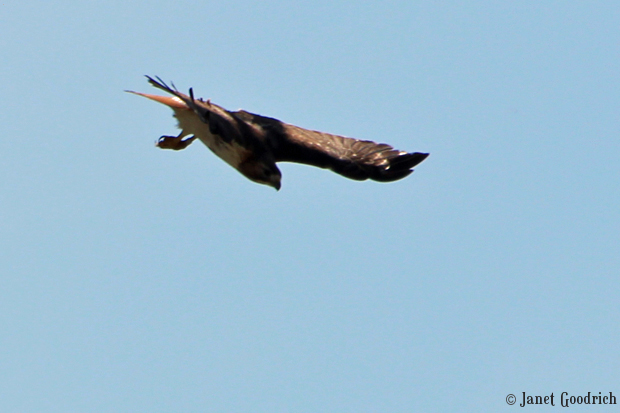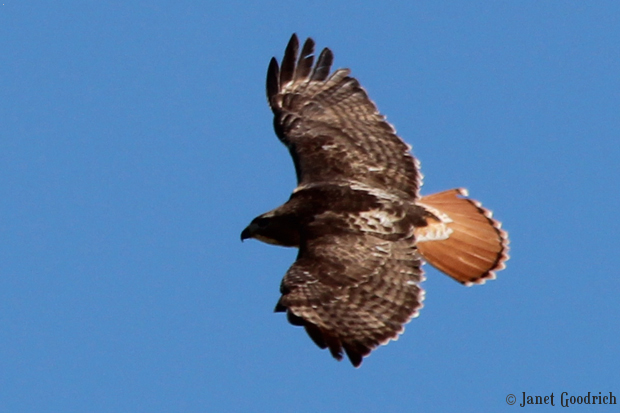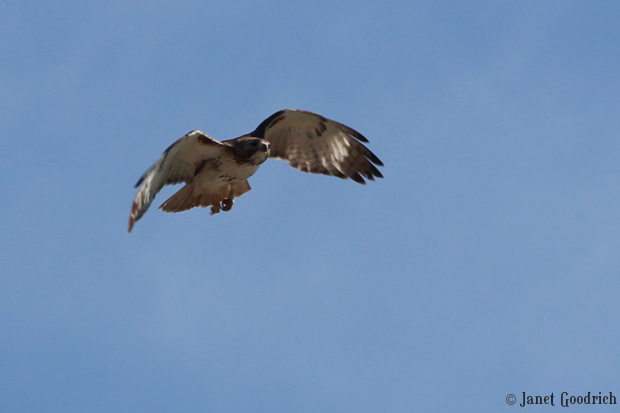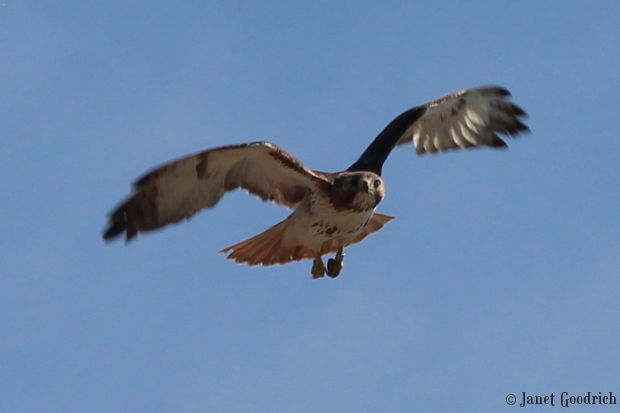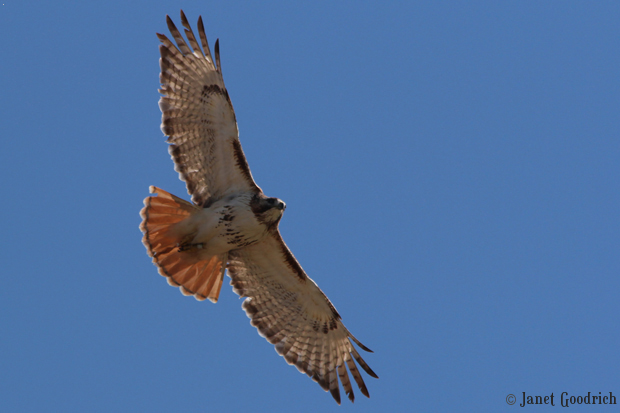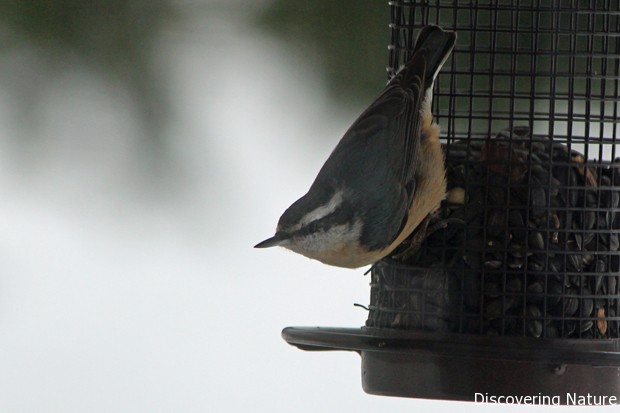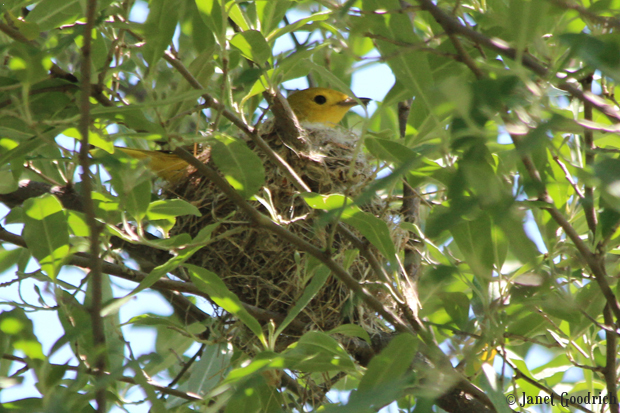-
Final fledge, and other neighborhood hawks
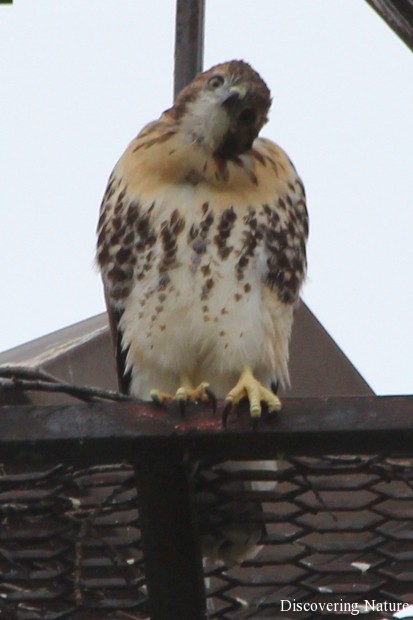
Chick #3 a few hours before fledging The girls and I went to Cornell yesterday morning with the awareness that it would probably be fledge day for the final eyass. As it turned out, the chick did fledge, but not till later in the day. It was chilly and overcast during the two hours we waited at the nest site, and though we did see all three chicks, there wasn’t a lot going on.
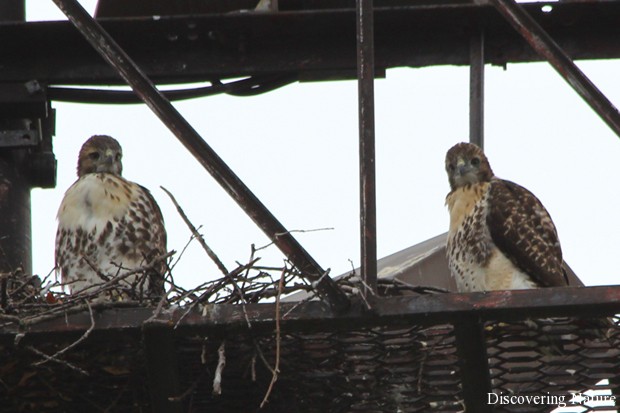
“Look, Sis — it’s the two-leggeds again.” 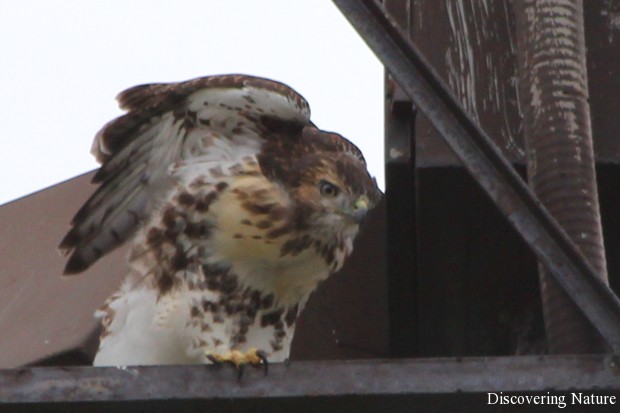
Imagining flight… 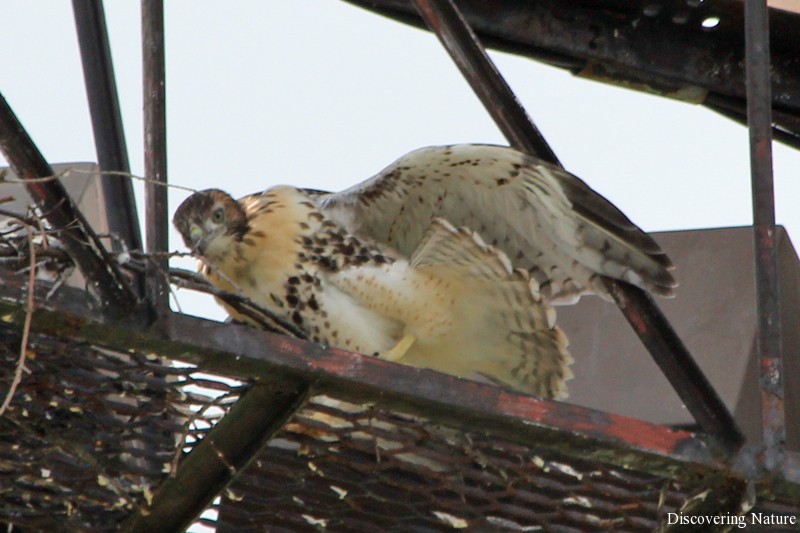
Big stretch For a tenth of what my parking ticket cost last week, I purchased a two-hour visitor permit, and during that time the girls and I enjoyed meeting a few other folks from the hawk chat. Almost everyone who drove, biked, or walked past did so while craning their necks, looking up at the tower. Everyone seemed aware of C3; one young woman who passed by said that she walked by every day on her way to work. “I think about how amazing it would be if the third one jumped off and flew while I was on my way past!” she said.
The chick’s first flight was marvelous, and probably the first intentional fledge of the three. The first two appeared to fledge by accident, blown from their perches by a breeze, but this one took off like a pro. I wasn’t watching at the time, so I was glad for this video capture.
Best of luck to you, C3!
My parking permit ran out around 1:00, just as the sun was starting to break through. So we ate our bag lunches and then drove around for awhile, visiting some sites of interest to us raptor geeks.
One was a large pheasant farm to the Northeast of the nest. Someone told me that it produces pretty much all of the pheasants in the state, and when it was proposed recently that funding be cut because of the state’s economic woes, there was quite a protest.

One of the three or four fields of pheasants However, it’s not only humans who appreciate the pheasant farm. There were flocks of pigeons, crows, and blackbirds there, pilfering the feed (or so we guessed). One turkey vulture visited, for some mysterious reason. I’ve heard that they frequent natural gas lines because of the smell of decay. I doubt that there were any dead pheasants around; it’s to all appearances a very well-maintained farm. But maybe there was some other explanation.
A pheasant would be too heavy for a hawk to carry away in most cases. But the pigeons and, likely, small rodents attracted by the feed must in turn attract hawks, because there was a pair of redtails there.
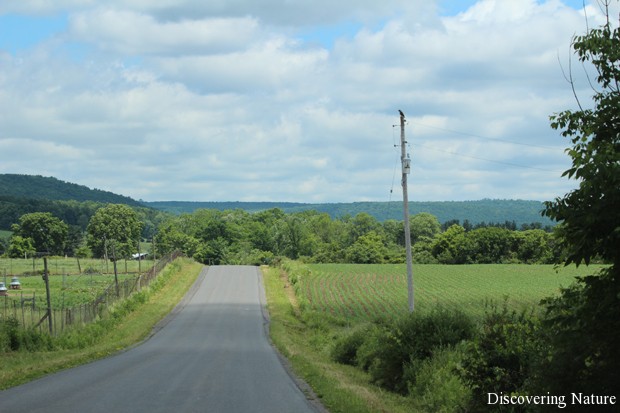
A hawk perches on the right-hand pole, studying the pheasant farm across the road. 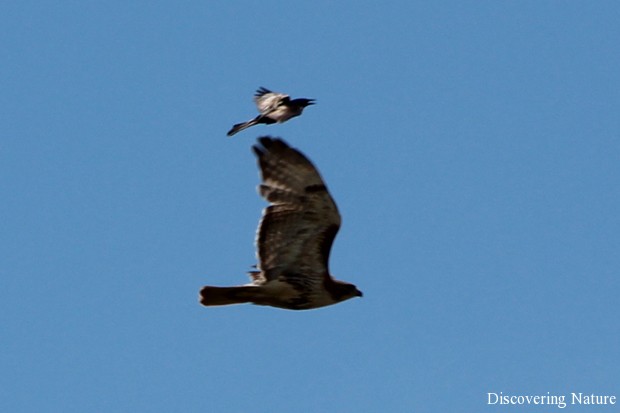
A harrassed hawk Just to the southeast is a long field of utility poles. The southern end of the field is visible sometimes when the cam pans the landscape near the cemetery where Ezra is thought to hunt. Back in April, we observed a pair of redtails actually mating atop one of the poles. They were there again yesterday.
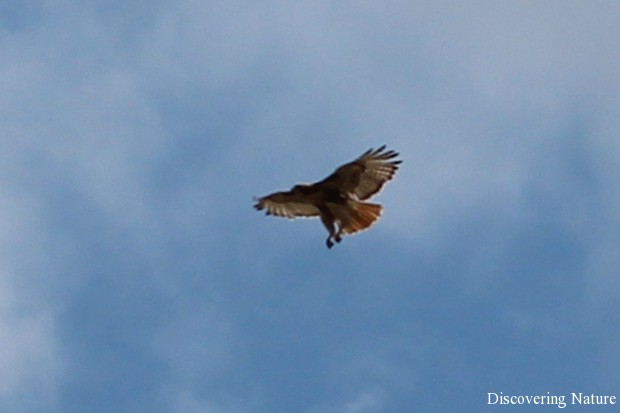
Hawk flying with legs down — a new sight for me 
A hawk is perched on the near pole. Bradfield Hall, a tall brick building near the cam hawk nest, is visible in the distance. Was this one pair of hawks, or two? Was the pair monitoring the pheasant farm Red and Ezra? We could only be at one place at a time, but we can say for sure that there is at least one other pair of redtails in Big Red and Ezra’s near neighborhood, and perhaps two. The utility field hawks look enough like Red and Ezra to be twins, but they’re definitely different hawks based on what we observed back in April.
It was interesting to get a slightly expanded sense of the hawk neighborhood. Watching the cams, it’s easy to develop tunnel vision, but the hawks live in a place full of raptor-friendly habitat. I’m sure they all have their invisible but well-defended “property lines” and the place will be full of young hawks learning to fly and hunt this summer.
Probably not everyone is excited about this!

Timmy Tiptoes, posing for me across the street from Red and Ezra’s nest -
Cornell Hawks: An 11-year-old’s view

Artist at work My daughter has been documenting the drama of the hawks featured in Cornell University’s red-tail nest cam. It was not an assignment, but something she’s done on her own initiative. There have been multiple revisions of some of the pages as she’s worked to get the details right in illustration and writing.
Last week we visited the campus and were there when the first chick fledged. She came home and finished the project. I think she’s done a really great job of capturing the highlights of the red-tail family’s journey! So I’m sharing the book here as a tribute to her diligence as well as to the impact of the cams as an educational experience.
Yes, there will be more to the story of the hawks, but this is probably where this particular book will leave it. She may go back and type the text and tweak here and there, but the substance is completed. I’m glad she stuck with it all the way to the end! It testifies to the impact learning and caring about something can have.
I’ve written about our real-life visits to the hawks on April 7 (at my other blog), May 12, May 27, and June 6. A few more thoughts and pics from June 6 are here. Our family has had a great time following them through the nesting season!
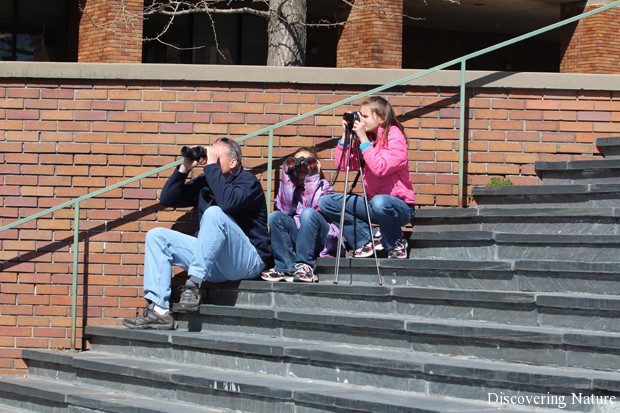
3/4 of the Raptor Geek Squad, April 7 I’m submitting this post to the Outdoor Hour Challenge, to be published on the last day of June.
-
Red’s ledge
I wanted to share a few last photos of our Cornell trip yesterday.
Twice now, when we’ve visited the hawks, Red has spent some time perched on a ledge of the building across the street from the nest. She enjoyed the sun there yesterday before Chick 1 left the nest. Maybe it’s a sauna-type experience for her, surrounded by warm brick.
It’s not necessarily easy to see her there, though — till you step back a bit.
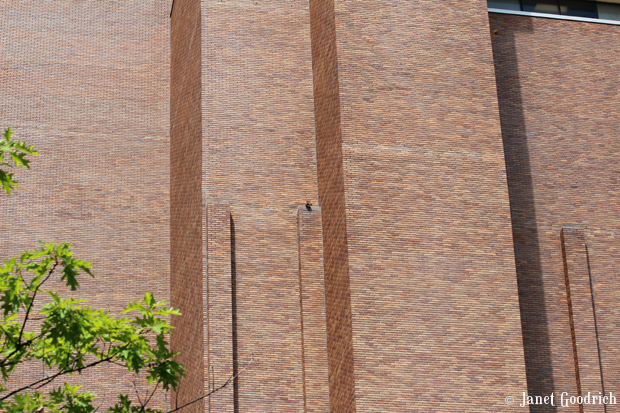
Find that hawk She is such an athlete. I love to see the power when she launches, unfurling all that energy and strength.
She sets a great example for young birds with much to learn about mastering the air. The hawk chicks watched as they practiced their own feats of daring.
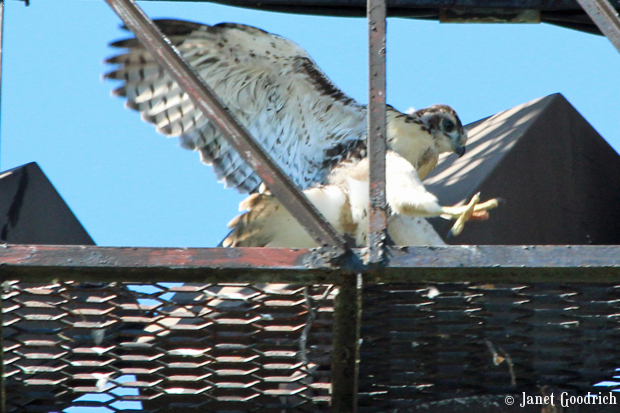
"Let the wild rumpus begin!" While two of the hawklets flapped and considered, the third power-lounged.
Yesterday as we drove home, I had the bittersweet awareness that we won’t be able to follow these young hawks much longer. I think it was a classic empty-nest feeling. Part of me is relieved that I won’t know all the scrapes they get into. But I’ll always wonder how they fared.
I hope that they find the wits and resourcefulness to rise to every challenge.
These hawks have parents who show them how it’s done with grace.
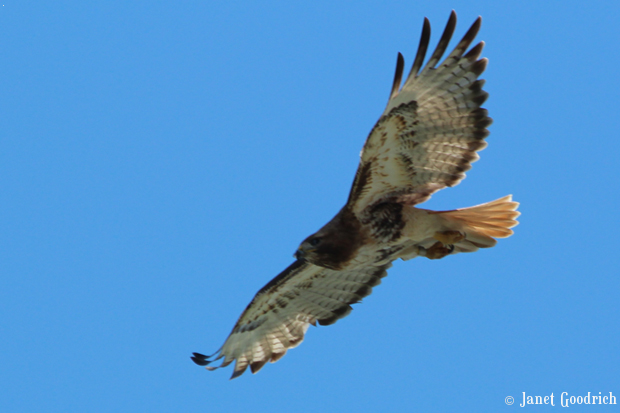
Big Red 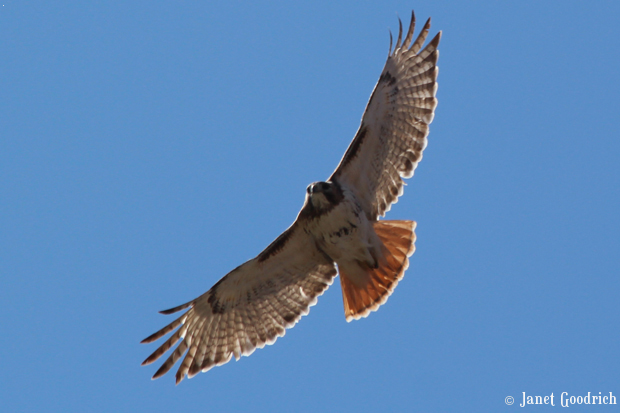
Ezra (photo from April 7) -
Fledge!
My daughters and I had a feeling today would be the day that one of the Cornell hawks would fledge. So capitalizing on the flexibility of schedule homeschooling gives us, we made the hour’s drive to Ithaca on this glorious sunny morning.
We were watching the cam when the first hawkling made its appearance after a spring snow. We’ve been watching the cam through numerous feeding and flapping sessions. But it was a thrill indeed to be there at the moment of the first fledge!

Hawkling on the landing, pumping its wings 
Getting ready to... 
FLY! 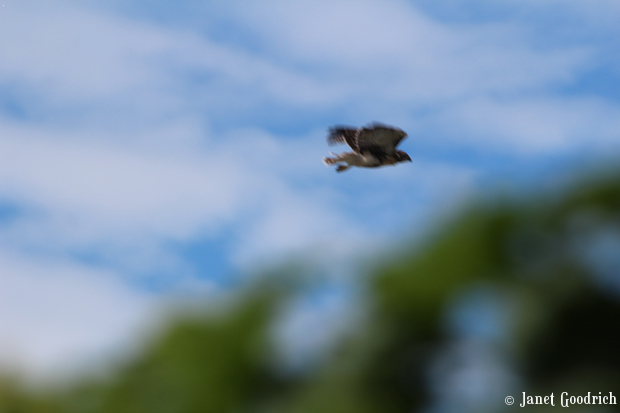
Into the wild blue yonder Where did it go? After an anxious search of nearby trees, a fellow hawk-watcher located the fledgling on the ground at a busy corner of the building across the street.
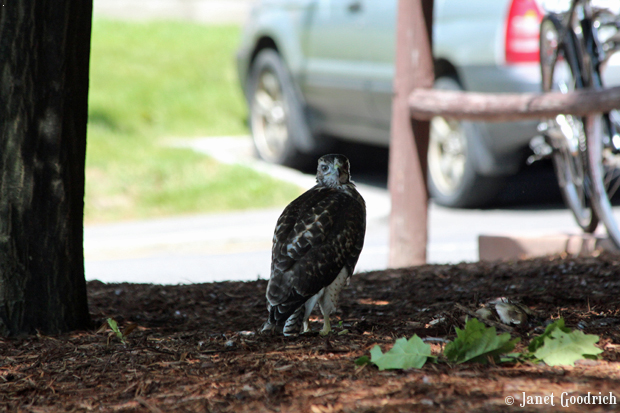
Feeling the ground for the first time A crowd was congregating, and I was getting nervous. It’s an awfully busy spot for a young hawk. But the crowd served the purpose by alerting drivers to something unusual going on, and any cars that drew near slowed way down.
After perhaps ten minutes on the ground, the young hawk gathered its nerve and flew, screeching, across the street and into a small oak — where it landed upside-down and dangled for a minute. It was a tense moment, but eventually the fledgling righted itself.
Red had flown over a few times, way up high. She was on a light pole across the fields when the youngster took flight. We left, hoping to give the bird some space to calm down and get reconnected to its parents. Ezra was on a roof nearby, preening, and I’m sure Red wasn’t far away. I got some great flight pics of her; I’ll post them tomorrow, as well as a few more of the chicks in the nest.
We’re grateful to Cornell for this experience! We’re wishing the young hawks well as they move into this next steep learning curve on their way to adulthood.
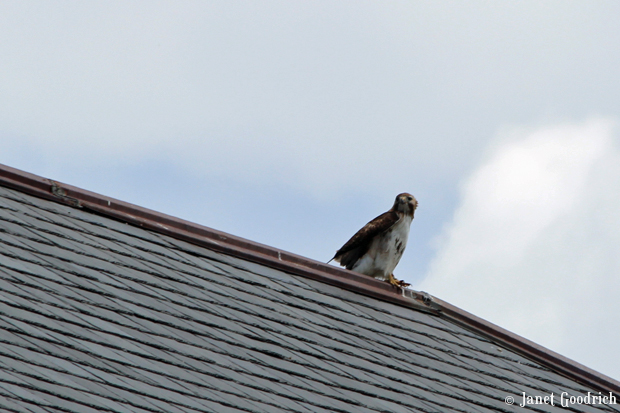
Ezra -
Scenes from Ithaca
On the way to Ithaca the other day, we saw this American kestrel hunting beside the road. They are such beautiful little birds! It was perched on a lightpost, then it fluttered to the power line, studying the ground in search of lunch.
He’s so beautifully colored; he looks painted. We see them sometimes hovering as they hunt, but this one put on no such show for us.
Having survived the decision to stop beside a busy thoroughfare to snap pictures of a kestrel, we went on to Taughannock Falls for a hike.
We took the trail up to the top of the falls and looked down on some of the smaller falls from above.
We met some turkey vultures along the rim.
It was a walk of a few miles, and though the overcast wasn’t great for photos, it made the heat much more bearable. The girls were ready to wade when we got back to the bottom, so we joined the rest of the multitude of people and polliwogs there, splashing around.
We hadn’t seen any songbirds, though we’d heard a few insistent warblers up along the rim. But after we packed away the cameras and went across the road to use the rest rooms before leaving, the trees were full of birds: cedar waxwings, warbling vireos, and I even caught a glimpse of an American redstart.
We visited the hawks after that, and as we were leaving Ithaca we made a brief diversion to Sapsucker Woods. The Visitor Center was closed for the day, and though the trails were still open, it all had the peaceful atmosphere of a place being reclaimed by its inhabitants. A squirrel sunned itself on a railing and watched us drowsily. A ruby-throated hummingbird — a species I have seldom seen in any other mood than territorial fury — shook out its feathers and rested. Turtles eyed us from the grass. A couple of orioles caroled from treetops. Everything about the scene radiated a quieting spirit.
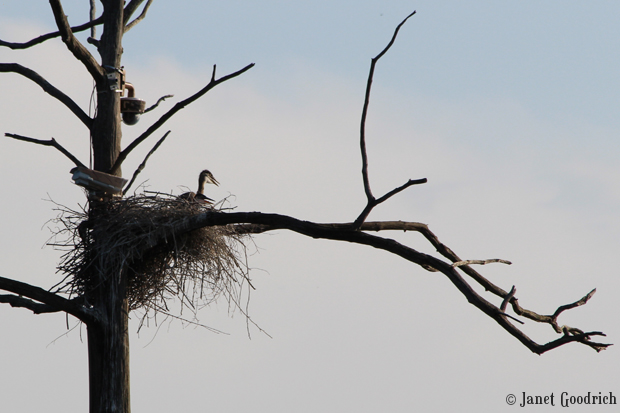
No visit would be complete without a look at these guys. 
This guy ran full-tilt toward my daughter -- then turned and high-tailed it away when he saw himself being photographed! 
Smile, friend! 
This turtle was sunning itself in the middle of the pavement, so we moved him. All in all it was a full day, rich in beauty. We always have the sense of barely scratching the surface when we visit Ithaca.
-
Cornell Hawks: Preparing for Takeoff
We’ve visited the red-tailed hawks at Cornell a couple of times. Yesterday, we saw them again, and I couldn’t help but wonder if it would be our last time. The hawklets may be flying before we get back!
They’re large enough to see easily from the ground now. We got there in the late afternoon, and over the hour or so that we were there, we saw two of them; the third, we saw on the nest cam, was resting out of our sight.
It was a hot one, and they were panting. (So were we!)
Ezra was on a nearby light pole, keeping an eye on things. Initially we didn’t see Big Red, but after a few minutes we saw her on the nest with the chicks. I’m not sure whether she flew in while our eyes were elsewhere, or whether she just changed position so we could see her better. In any case, she had a mission in mind that involved a short flight.
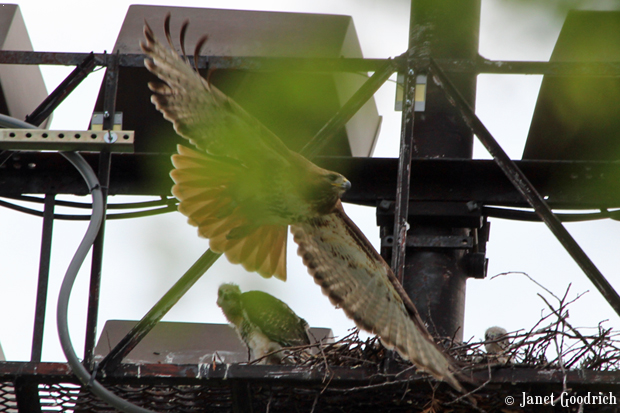
“Someday I’m gonna fly like Mom!” Obviously I was photographing this in a window through the trees. She flew over Older Daughter and me, and into a small tree about 40 feet from where my husband and Younger Daughter sat on the steps of the building across the street! There she proceeded to rip some home improvements from the tree while a chorus of small birds scolded from the neighboring branches.
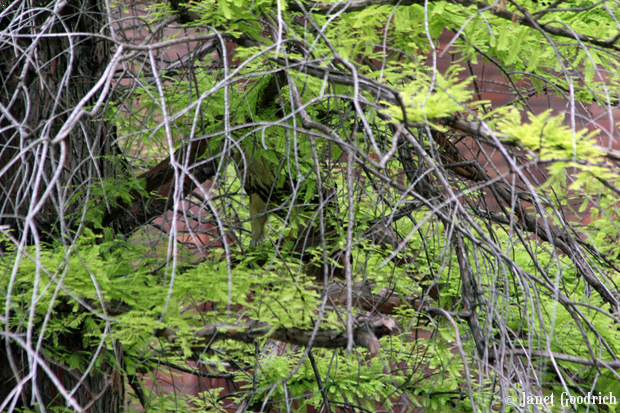
Hidden picture exercise: Find that raptor! She flew back to the nest with her hard-won beakfull of bark. It was hazy, and the light doesn’t bring out her color as much as I’d like, but she is so amazing in flight — beautifully marked and powerful.
Back at the nest, she deposited the bark and headed off across the neighboring athletic field. She perches farther away than Ezra, who has picked a lightpost on the same field as the nest both times we’ve visited recently. She spent her time eating something atop the pole, circling a little, and landing on a neighboring pole.
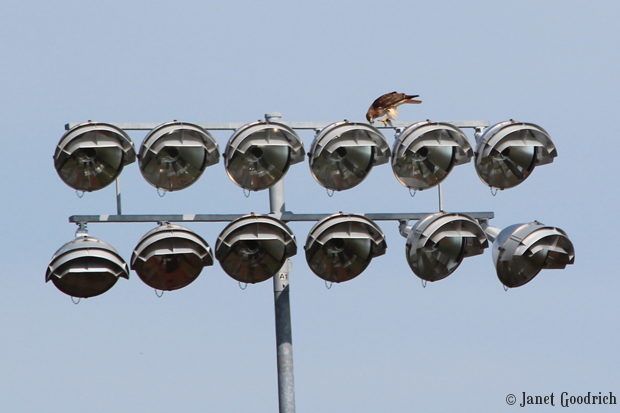
Do red-tails wipe their beaks? This is after she finished eating. 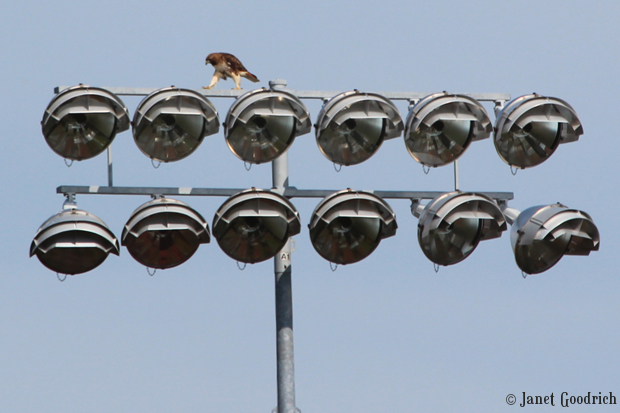
Walking to the other end… Meantime, back at the nest, one of the hawklets practiced flapping.
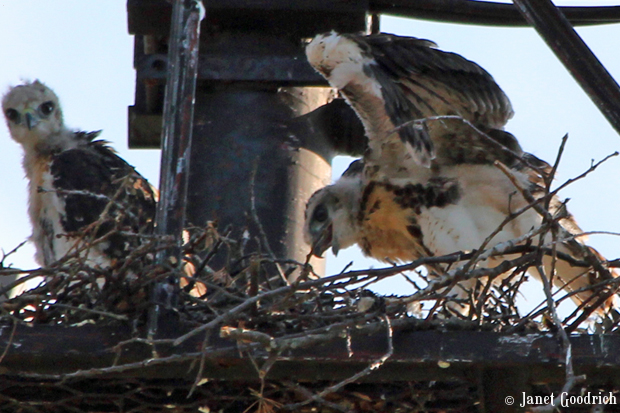
“Can we help you with something?” 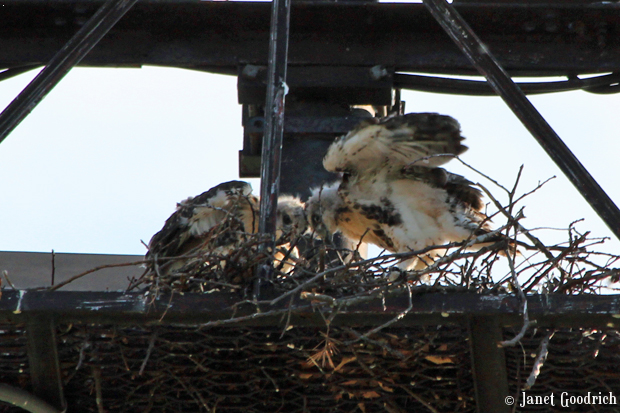
Head bump (or assist) Ezra had taken off shortly after we arrived, and we saw him getting mobbed across the field.
He must have held his own, because he arrived back at a lightpost near the nest.

“You with the camera again??” We were about ready to leave, but we waited a few minutes more just in case Red flew back across to the nest. Instead, Ezra launched from his post, and she followed a few moments later. They circled together and went out of sight.
We decided to take their cue and head out ourselves. We’d seen what we came to see. The most incredible experience was seeing Red in that tree, so close, yet so intent on her bark-ripping!
I wrote about our other two hawk visits here (at my other blog) and here.
-
Migration Celebration
On Saturday we visited the Cornell Lab of Ornithology for their Migration Celebration. It was an opportunity to see the many kinds of work they do at the lab: raptors, bird banding, nest and birdwatching walks, audio and video archiving, crafts and face-painting and ice cream. (Okay those last three aren’t especially bird-related…)
A highlight for my daughters was the bird banding demo. They got to see the mist nets used to catch birds because there were some set up near the feeders. We saw them band a goldfinch, two downy woodpeckers, a mourning dove, and a chickadee.
I have mixed feelings about bird banding. I’m sure it yields interesting information. But is it interesting enough to make the birds wear those bracelets forever on their delicate legs? I never really thought about it till I read David Kline’s Great Possessions. He quotes Gene Hill:
I have nothing against scientific observation, census, or just plain curiosity. I am as interested as the next ignoramus about the curious life cycle of the migrating butterfly or the whereabouts of the black-footed ferrets, but I think there are some technological gadgets that we could resist in the name of decency, even if life is a little more incomplete without them.
I’m alone in my ambivalence, however. My whole family LOVED the banding. (My husband even wants to learn how to become licensed as a bird bander.) And there was certainly great emphasis on reducing the stress of the whole experience as much as possible for the captured birds. Both girls got to release a banded bird, which, from the looks on their faces, was an incomparable experience.
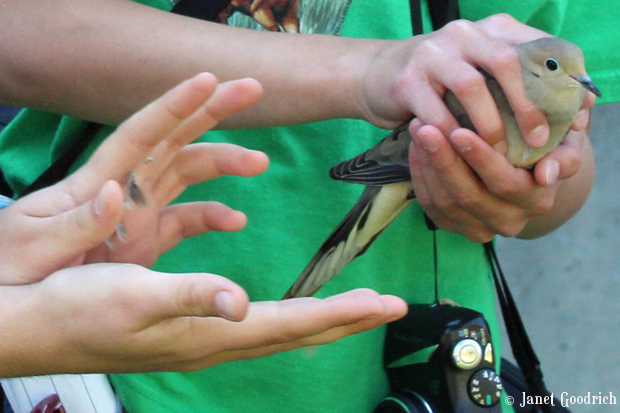 We went on a walk with an ornithologist who brought recordings of birds — chickadees and titmice sounding the alarm over a screech owl — to lure the birds in close. I’ve always been hesitant about such walks because I thought the birds would stay hidden from a group of people making noise, but we saw several birds — yellow warblers, common yellowthroats, chickadees, titmice, woodpeckers, grackels. We also saw (and heard) a bird that I’ve heard of but never seen: a blue-winged warbler.
We went on a walk with an ornithologist who brought recordings of birds — chickadees and titmice sounding the alarm over a screech owl — to lure the birds in close. I’ve always been hesitant about such walks because I thought the birds would stay hidden from a group of people making noise, but we saw several birds — yellow warblers, common yellowthroats, chickadees, titmice, woodpeckers, grackels. We also saw (and heard) a bird that I’ve heard of but never seen: a blue-winged warbler.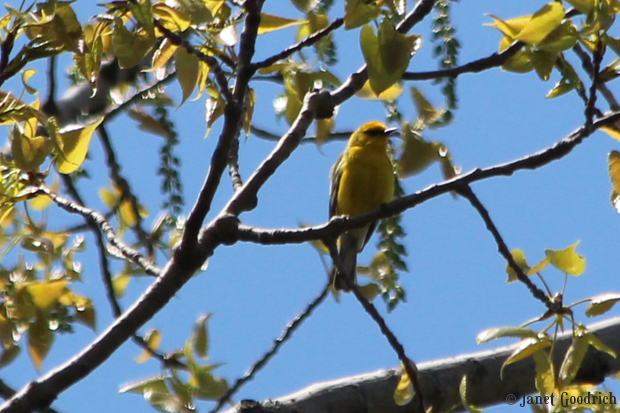 It was an impressive showing, especially given that it was high noon! I learned to distinguish the calls of the blue-wing and the yellowthroat, so on the whole it was quite educational.
It was an impressive showing, especially given that it was high noon! I learned to distinguish the calls of the blue-wing and the yellowthroat, so on the whole it was quite educational.Out back were a number of raptors on display. It’s always a thrill to see one up close, and to glean tidbits from their handlers.

Golden eagle panting in the heat 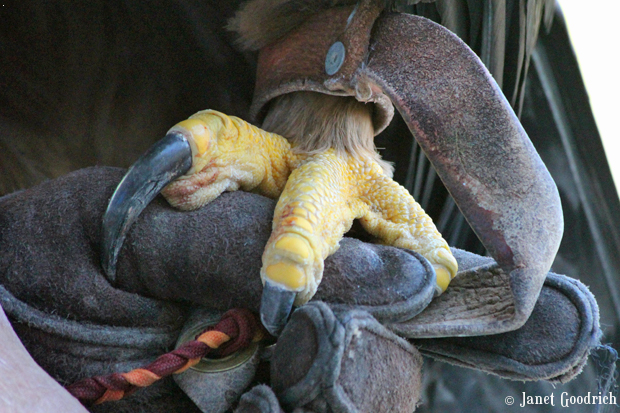
Golden eagle talon 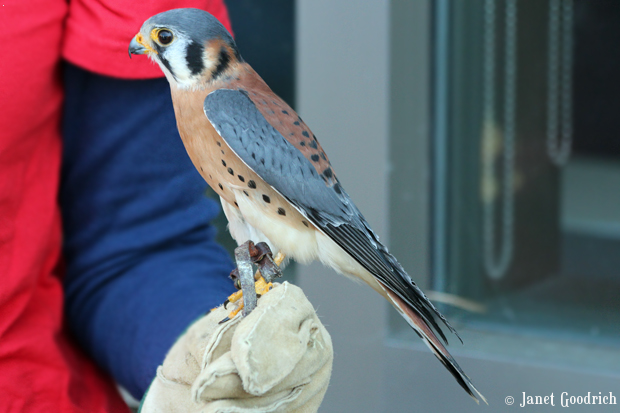
American kestrel 
Merlin 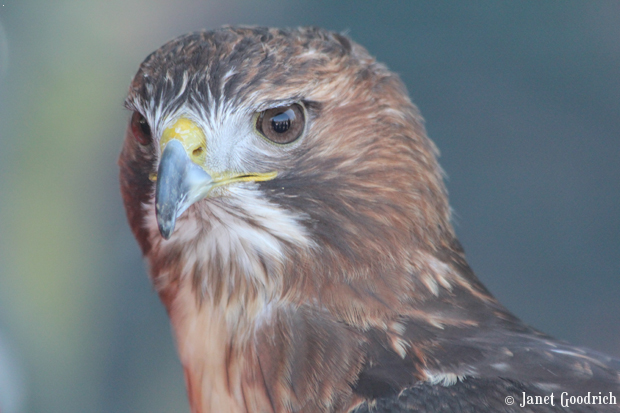
Red-tail 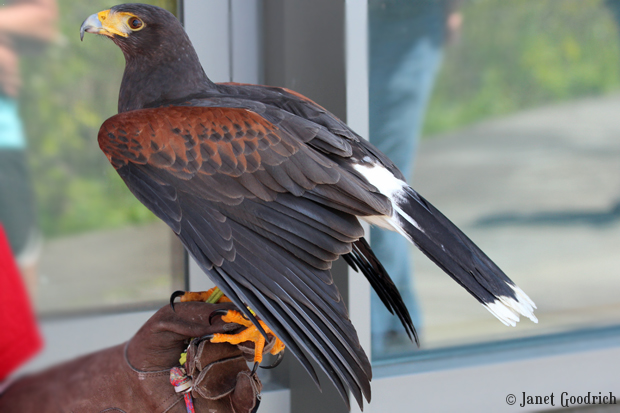
Harris hawk 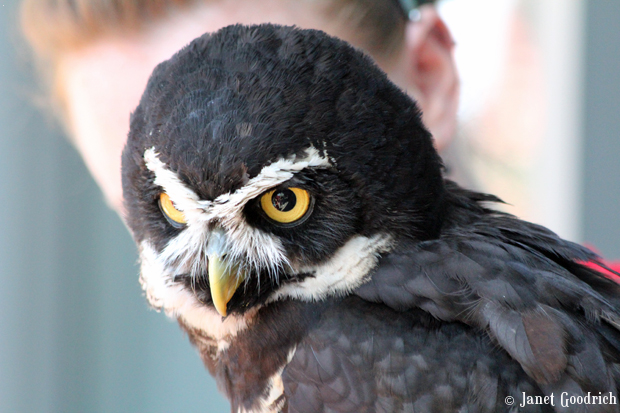
Spectacled owl 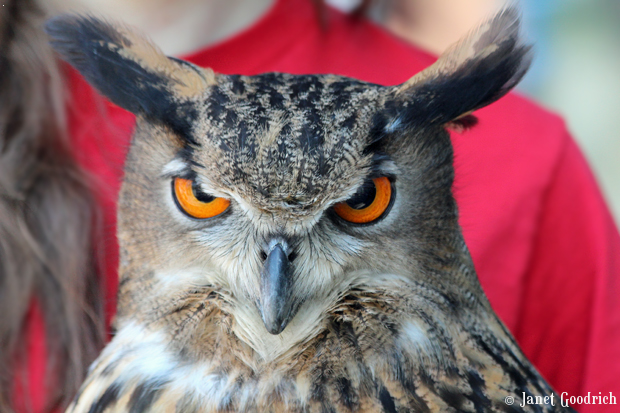
Great horned owl 
Mix of three kinds of falcons 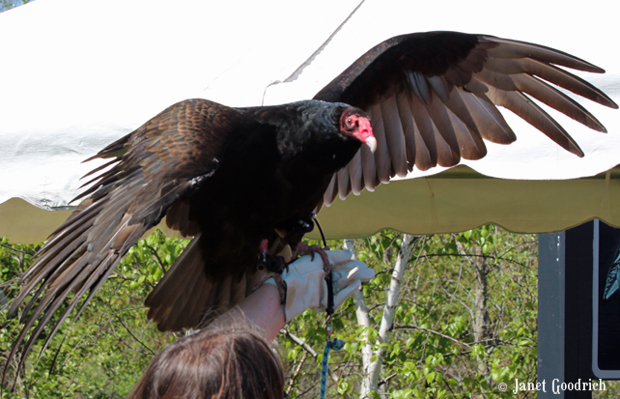
Tuvu the turkey vulture greeted everyone on their way in. We had a gorgeous sunny day for the event and found it all very stimulating, but the eagle owl reminded us that he was out past bedtime!
-
Cornell Hawks and Hawklings
We made our second trip to visit the hawks featured on Cornell’s webcam on May 12. It was Cornell Lab of Ornithology’s Migration Festival, and our family went to the lab to enjoy this opportunity to get a glimpse of all the many aspects of the Lab’s work. I’ll write more about it in another post.
After a full schedule of events there, we stopped by the hawk nesting site on Tower Road to see what we could see. Ezra (the male) was on the nest when we arrived, and Big Red (the female) was perched on a light tower across the athletic field from the nest.
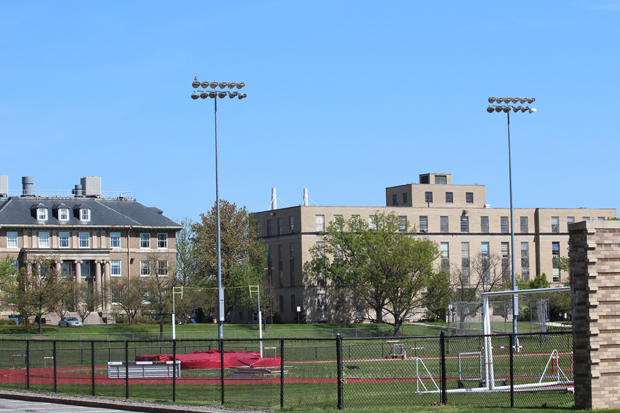
Big Red is perched atop the left-hand pole. 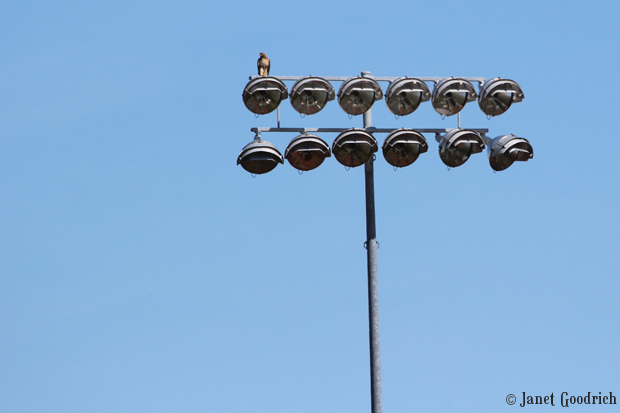 We stayed for about 15 minutes, but that was all the time we had. As we started for the car, I saw Red flapping back toward the nest. I was not in the best position any longer, shooting toward the sun, but I snapped a few shots of the shift-change. Big Red was quite vocal when she returned to the tower, and Ezra didn’t wait long to dive off and head for a nearby light pole.
We stayed for about 15 minutes, but that was all the time we had. As we started for the car, I saw Red flapping back toward the nest. I was not in the best position any longer, shooting toward the sun, but I snapped a few shots of the shift-change. Big Red was quite vocal when she returned to the tower, and Ezra didn’t wait long to dive off and head for a nearby light pole.He seemed to consider for a few moments. Then he took off and sailed into the blue. He was aware of us but didn’t appear to be threatened at all.
It’s strangely stirring to see a hawk taking flight. Science can answer so many questions, but not all of them. In the end we’re one species observing another, separated by a gulf of differentness, but joined by a kind of respect and wonder in watching the strength and grace of that spiral into the sky.

